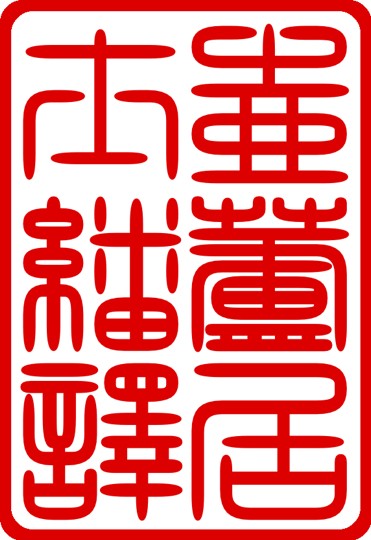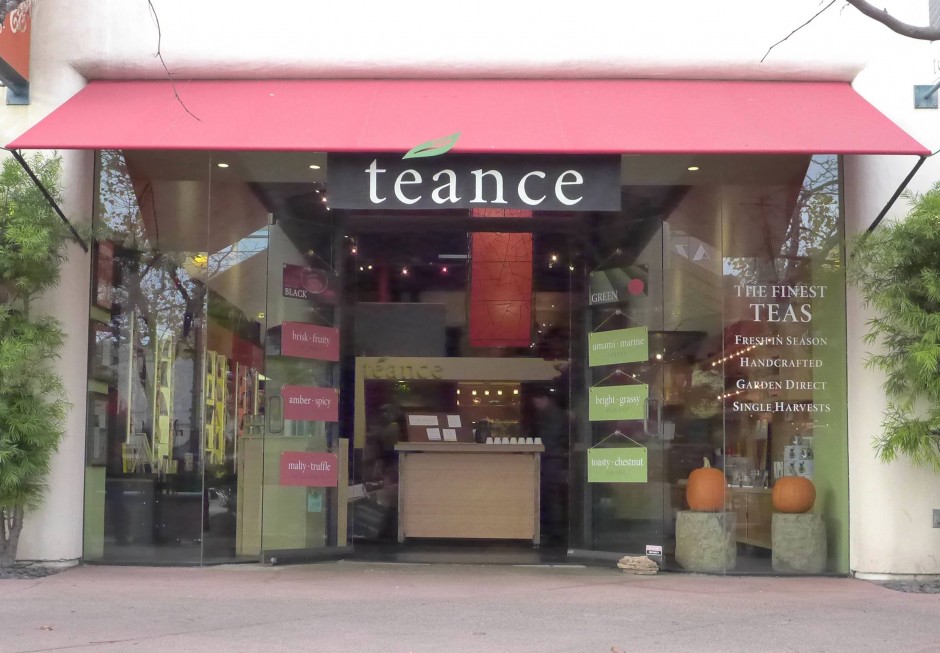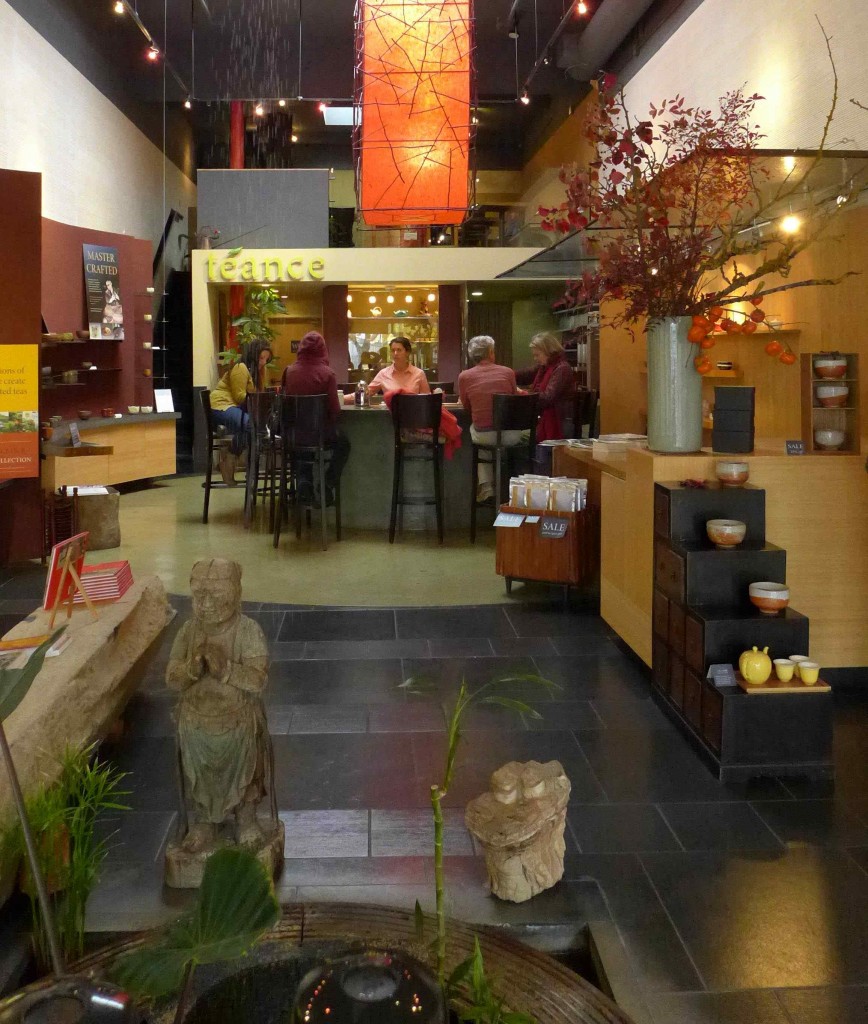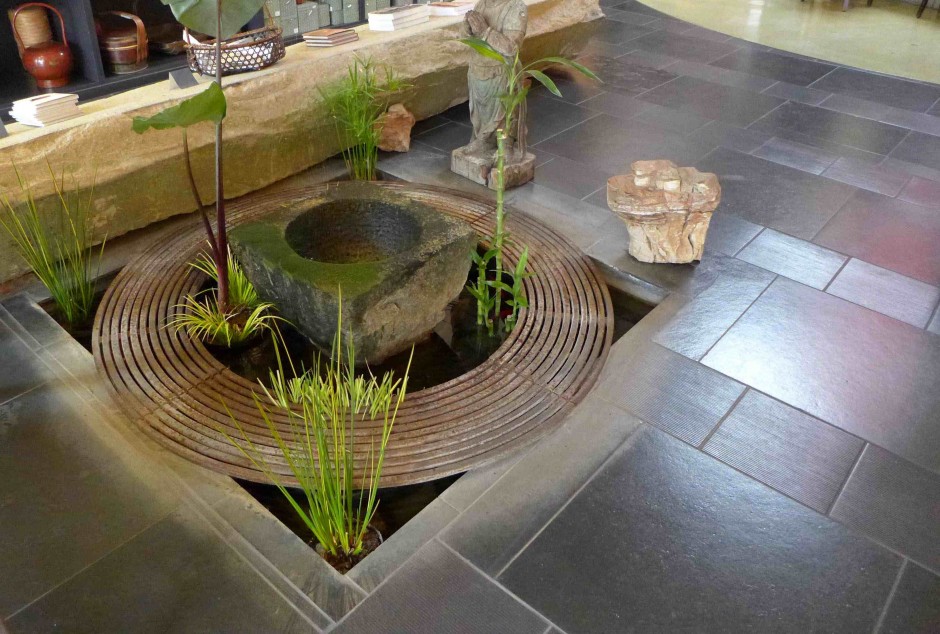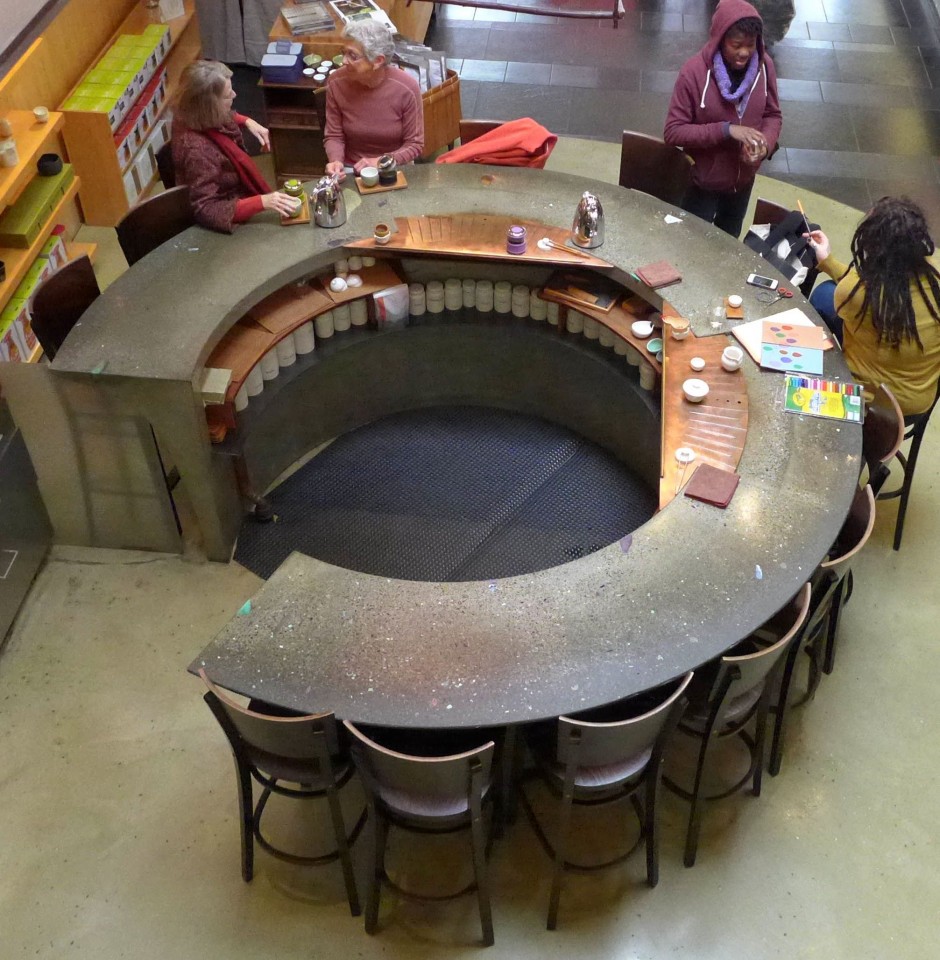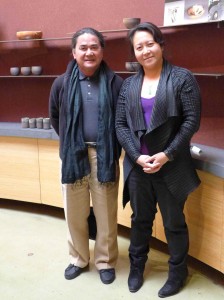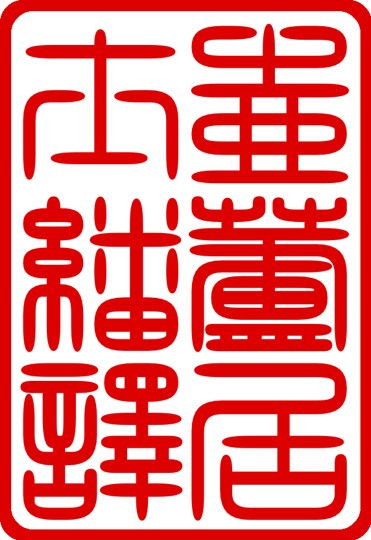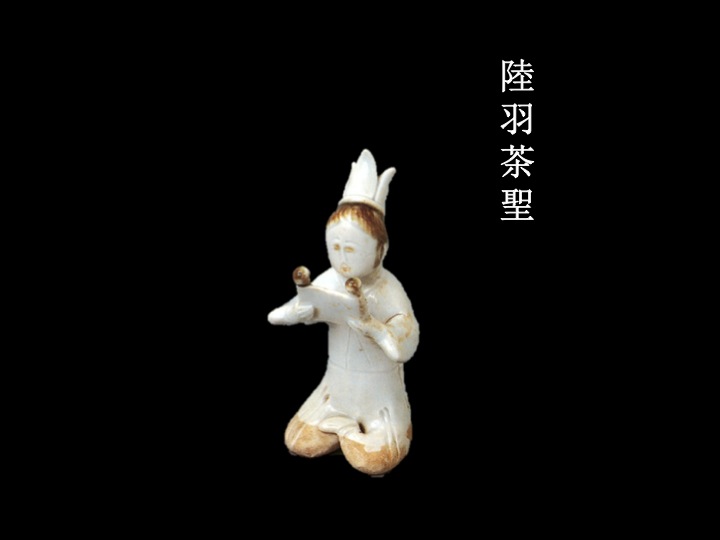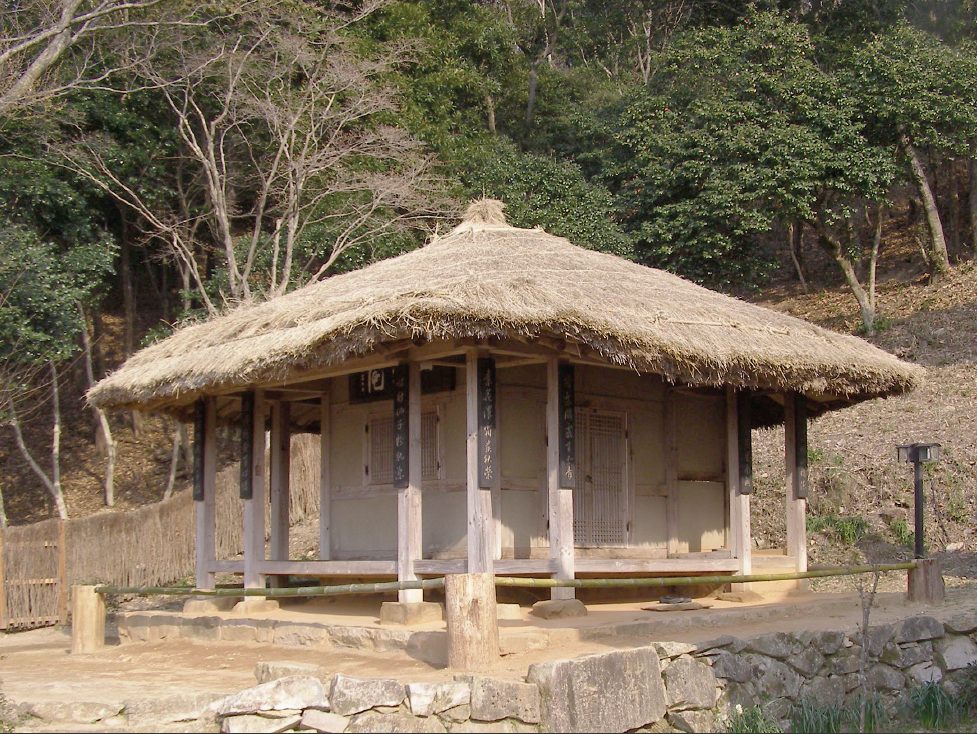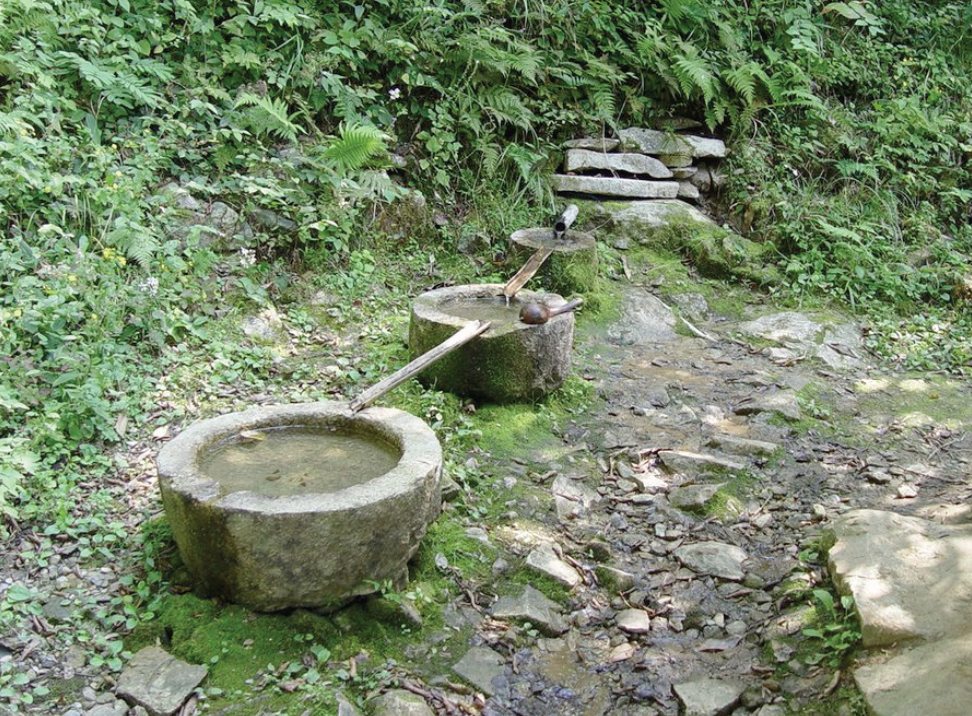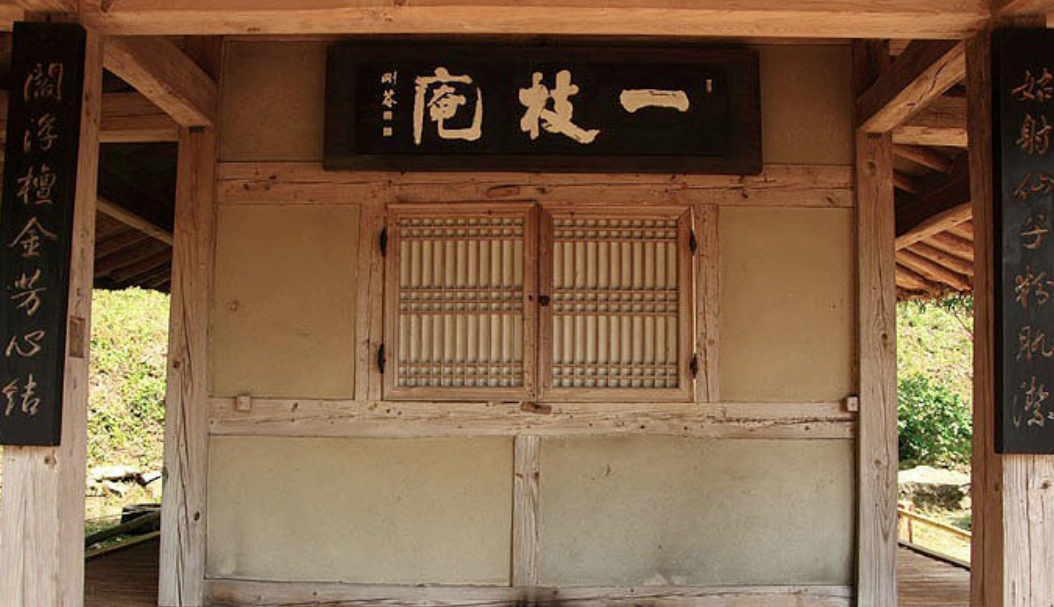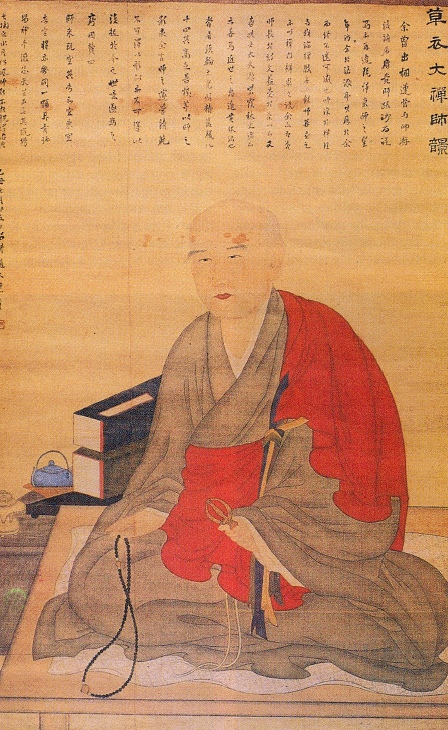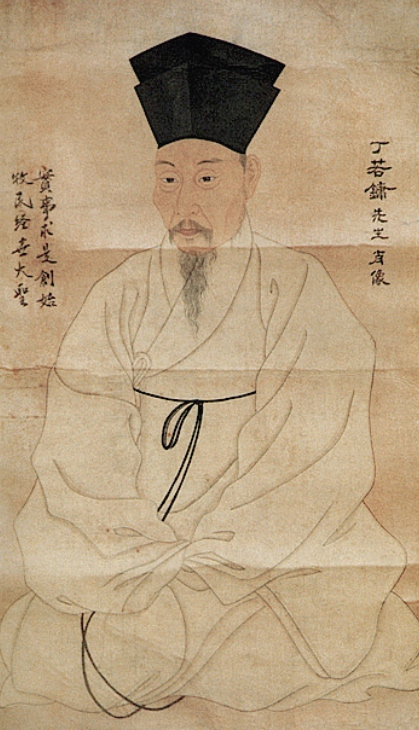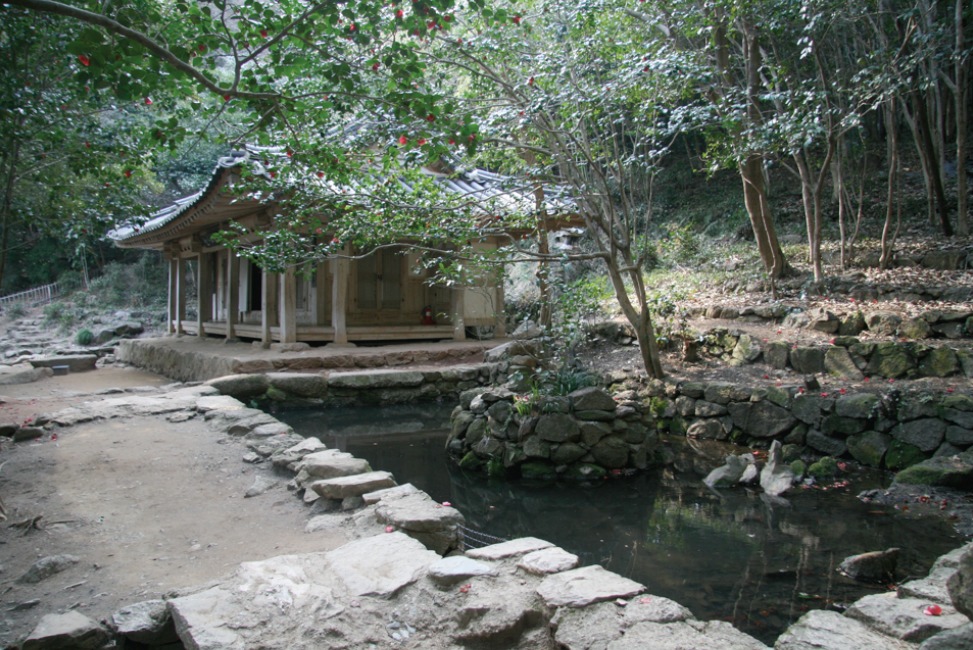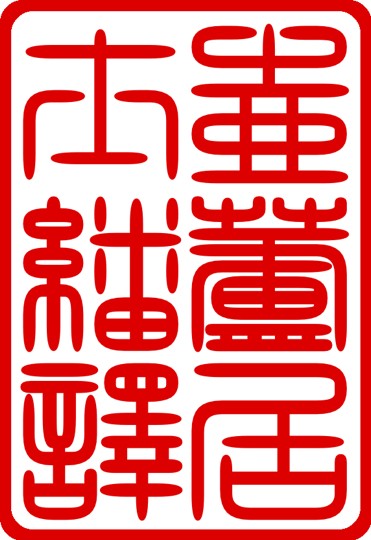Wandering Immortal
Guo Pu of the Eastern Jin
Poem Nine of Nineteen Poems on Wandering Immortal
Picking herbs, roaming the great mountains:
I deter the decay of old age.
Nurturing breath and liquid jade:
A marvelous spirit fills the breast.
Becoming immortal, I steady the dragon steeds,
Driving hard the thundering chariot.
Scales send forth bright lightning,
Canopied clouds trail swirling winds.
Reining in the traces of the Sun chariot,
I stamp my foot to open Heaven’s Gate.
The Eastern Sea is like a puddle in a hoof print,
Mount Kunlun, an anthill.
So vast and boundless the Void,
To behold the abyss makes one despair.
東晉 郭璞
郭璞全集
游仙詩十九首
第九
採藥游名山
將以救年頹
呼吸玉滋液
妙氣盈胸懷
登仙撫龍駟
迅駕乘奔雷
鱗裳逐電曜
雲蓋隨風回
手頓羲和轡
足蹈閶闔開
東海猶蹄涔
昆侖螻蟻堆
遐邈冥茫中
俯視令人哀
Sources
閔福德 和 劉紹銘, 主編 (John Minford and Joseph S.M. Lau, comps.), 含英咀華 上卷: 遠古時代至唐代 (A Chinese Companion to Classical Chinese Literature: An Anthology of Translations) (Hong Kong: The Chinese University of Hong Kong, 2001), p. 164. Cf. Graeme Wilson, trans., “Vision: Second Poem of Wandering Immortals,” An Anthology of Translations: Classical Chinese Literature, Volume I: From Antiquity to the Tang Dynasty, John Minford and Joseph S.M. Lau, comps. (New York: Columbia University Press, 2000), p. 438.
Puer Tea: Ancient Caravans and Urban Chic
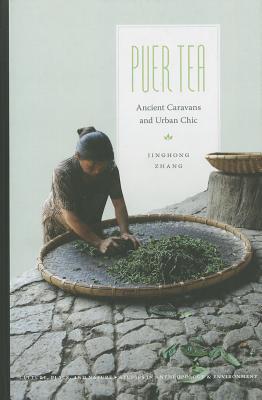 Puer Tea is a study of the tea industry in the distant southwest province of Yünnan. The book traces the path of the Chinese tea known as Pu’er from the remote villages along the Tea Horse Road to the elegant salons of China’s cosmopolitan centers. Author Jinghong Zhang presents her report as a “cultural biography” and centers on the tea business during the decade 1997-2007 when Pu’er tea was a commercial and culinary phenomenon that swept the tea drinking world. She takes a penetrating look at Pu’er tea through the lens of the anthropologist, a perspective sharply focused on the varied spheres of tea, from cultivator to connoisseur.
Puer Tea is a study of the tea industry in the distant southwest province of Yünnan. The book traces the path of the Chinese tea known as Pu’er from the remote villages along the Tea Horse Road to the elegant salons of China’s cosmopolitan centers. Author Jinghong Zhang presents her report as a “cultural biography” and centers on the tea business during the decade 1997-2007 when Pu’er tea was a commercial and culinary phenomenon that swept the tea drinking world. She takes a penetrating look at Pu’er tea through the lens of the anthropologist, a perspective sharply focused on the varied spheres of tea, from cultivator to connoisseur.
In the wide realm of tea books, Puer Tea is unusual if not unique in its exploration of the complex social relationships that permeate the tea trade, the intricate yet often opaque bonds that ultimately determine the character and quality of the tea we drink.
Zhang delves into the story of Pu’er tea by simply unfolding village farm life in deeply rural Yünnan. In the process, she artlessly reveals the convoluted social, ethnic, and cultural effects wrought by the sudden interest in a local product, a distinctive artisanal tea that is universally celebrated as Pu’er. Riven by demand, government regulation, hyperbole, and greed, what had been a supplemental cottage craft changed within a decade into a big business industry with both predictable risks and unexpected consequences. Zhang documents the processes by which villagers responded to outside forces like the media and government regulation and she explores the motivating logic of their behavior. Moving from producers to traders, she notes the complaints of tea buyers about the difficulties in finding quality leaf and observes the perils of their business when competition and market dynamics undermine the very relations on which their trade depends. She follows Pu’er tea from the countryside to the city where scientists and scholars are viewed with suspicion and defiance by traders, connoisseurs, and collectors.
Zhang took her inaugural journey into the heart of Pu’er tea in 2002 when she visited the secluded village of Yiwu in Xishuangbanna prefecture. The outside world was beginning to find its way through the back country roads and trails up into the subtropical forests alive with tea. Returning in March 2007, she became aware of changes among the inhabitants but could not have foreseen the events that would adversely affect them in the months to come. Seeking strength in numbers, the villagers formed the Yiwu Authentic Tea Mountain Company, Ltd. in response to government taxation and regulation. Meanwhile the provincial government implemented the Quality Safety Standards during an abnormally dry winter and spring season that severely limited the amount of premium leaves picked from the field. There was a dramatic rise in the price of processed leaves due to limited supply of quality leaf and cut throat competition, followed by a subsequent rise in production costs owing to price hikes and uncertainty of the tea supply. The newly christened city of Pu’er experienced an earthquake on June 3rd that presaged the collapse of the Pu’er tea market and the beginnings of a steep trade decline that was further damaged by the worldwide recession of 2008. In her study, Zhang provides an eyewitness account of a particularly crucial moment of upheaval in the Pu’er tea trade.
Zhang addresses the remarkable diversity and subtlety of standpoints on Pu’er tea from a position of considerable knowledge. Trained in China and Australia, she is expert in field anthropology and skilled in employing the range of requisite anthropological theories, methods and techniques, including video, photography, graphs, and maps. Furthermore, Zhang is from Yünnan and is intimately familiar with the dialectical languages of the province, local and regional values and traditions as well as the historical racial, ethnic, and religious sensitivities of the people. Dr. Jinghong Zhang is a lecturer at Yünnan University and a post doctoral fellow at the Australian National University.
In the eight chapters of Puer Tea, Zhang follows a scenario of rise, climax, and denouement in which Pu’er is initially framed as the single most important activity around which the economic life of one village in remote China is organized. Then the narrative shifts, and peasant interests in the tea harvest, processing, and production give way to the concerns of the urban trader to supply the growing Asian and global markets with fine Pu’er tea. Intent on preserving traditional methods and making an authentic and organic tea from wild and arbor stock, producer and merchant contend with government efforts to regulate production. State efforts to standardize and establish quality control not only result in mechanization and industrialization but also undercut authenticity and quality. Media interest and promotional hyperbole fuel annual inflation at every level – material, production, wholesale, and retail – until confidence falls and the market collapses.
Inspired by the traditional Chinese literary theme and agrarian motif of the four seasons, the author depicts the dramatic rise and fall of Pu’er tea as the promise of spring, the fulfillment of summer, the autumnal harvest, and the harshness of winter. She also employs other traditional ideals such as health, wealth and prosperity, frugality and simplicity, the return to the ancient, and the related compounded notion of the natural, the original, and the authentic.
Of all the Chinese notions, Zhang most deftly uses the concept of Jianghu to describe the chaos of the Pu’er industry. Jianghu is a historical and literary phrase meaning the “rivers and lakes” that described the aquatic landscape of the great region south of the Yangzi. In antiquity, the majestic river marked the boundary between the well ordered north and the anarchic south, between civilization and savagery. In ancient poetry and literature, Jianghu evoked not only an exotic land vibrant with color, texture, and spice but also an alien place of miasmic heat and humidity, barbarity, and the stigma of exile and death. Those who survived Jianghu became Jianghu and converts to a sub rosa culture that thrived on the uncertainties of life. As she writes throughout Puer Tea, the various persons in the book personify characters enacting different roles in a drama set in the turbulent world of Jianghu and tea.
While demonstrating a command of anthropological interests and fulfilling its requisites, Dr. Zhang presents Pu’er tea in a clear and colloquial manner that is easily understood by the lay reader. Her objective view inside the Pu’er industry is a welcome take, especially since the debacle in 2007 and given the opacity of the trade. Filled with insight and revelation, Zhang engagingly provides the reader an extraordinary glimpse into the riotous theater of Pu’er tea.
Jinghong Zhang
Puer Tea: Ancient Caravans and Urban Chic
University of Washington Press
2013
A Visit to Teance
Teance is the premier tea room in the San Francisco Bay Area. No other such place offers tea in either so thoughtful a manner or in so creative a space. The shop is nestled on a terrace above a quiet lane in the bustling 4th Street district of Berkeley. The wide awning and fully windowed front greet and open in welcome. On traversing the mosaic threshold, the very considered character of Teance is immediately apparent and directly appealing.
Once within, there is a momentary feeling of ascension. The eye soars to the high ceiling – brightened by skylight and an immense hanging lantern ablaze in orange red – only to drop precipitously to the ink black floor, a dark elaborate board of ceramic and stone tiles, each giving depth and mass to the fleeting instance of transcendence. Entering Teance gives the distinct sense of crossing into a world beyond.
The essential elements are everywhere. A garden pond invites with long stemmed aquatic plants and flashes of intense color as goldfish swim amidst the dark recesses of the pool. Water cascades gently from above into a mossy basin, pitter-pattering in asymmetric syncopation on stone, the shower ionically charging and freshening the air and filling the pond below. Follow the long weighty column of calcified basalt to the color muted interior, a smooth pale ground set sparingly with polychrome flecks of stone.
From the floor rises the exquisite tea bar. Cast in a single pour of fine concrete inlaid with stone, shell, and minerals, the counter inset with drain stations of pure copper, mottled and stained, on which to brew tea. Bearing a rich patina from use, the bar is unique, a mirror of the pond: forms of earth and water embodying the open ensō, the Zen circle of enlightenment and spiritual perfection.
Winnie Yu is Director of Teance and curator of the seasonal selection of teas from China, Korea, Japan, and India. Petite and gracious, she radiates a calm certainty from within the tea bar as she prepares and serves a succession of light to dark premium teas:
Anhui Yellow – a yellow tea from Mount Jin Zai, Anhui
Gyokuro – a green tea from Uji, Japan
Four Seasons – a wulong tea from Nantou, Taiwan
Phoenix Honey Fragrance – a wulong tea from Phoenix
Mountain, Guangdong
Yunnan Gold – a black tea from Yunnan
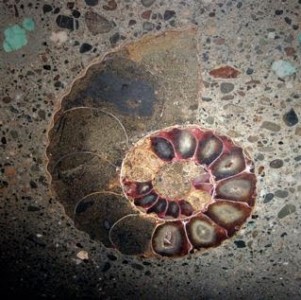
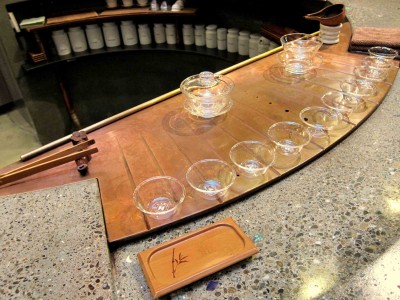 The simplicity of her casual gestures belies the masterful techniques by which she brews each tea. Frugality, economy, and practicality transform her motions into an elegant ballet. From one cup to another, the subtle rhythms of the leaf enfold as if notes on a score, lightly played yet resonant and deepened with every steep. She pours clear water into the gaiwan, then spreads green gyokuro in a circular motion into the cup. The tea floats a bit, as if surprised, and then rapidly sinks to provide a brew redolent with umami, the intense and savory taste – the pursuit and delight of the connoisseur.
The simplicity of her casual gestures belies the masterful techniques by which she brews each tea. Frugality, economy, and practicality transform her motions into an elegant ballet. From one cup to another, the subtle rhythms of the leaf enfold as if notes on a score, lightly played yet resonant and deepened with every steep. She pours clear water into the gaiwan, then spreads green gyokuro in a circular motion into the cup. The tea floats a bit, as if surprised, and then rapidly sinks to provide a brew redolent with umami, the intense and savory taste – the pursuit and delight of the connoisseur.
Yu hails from Hong Kong, where at the age of four she learned to drink tea. Her mother is the scholar Yuen Chuen Tam and her father, the renowned painter Chitfu Yu, who in 1978 moved the family from China to New York and presently resides in New Jersey.
Winnie graduated from the University of California, Berkeley, a city by the Bay where she stayed and prospers. Adhering to literati traditions, she melds the ancient and the new within the store: Yu translates old Chinese tea poems for her patrons, giving recitations and lectures; her father’s calligraphy graces its walls, his ink paintings filling the unexpected places. And Winnie Yu’s innate sense of the good and proper permeates the Teance experience. A revelation and a pleasure not to be missed.
Former Address and Numbers
Teance
1780 4th Street
Berkeley, CA 94710
510-524-2832
www.teance.com
Current Address and Numbers
Teance Fine Teas
In the Heart of South by Southwest Berkeley
1036 Grayson Street
Berkeley, CA 94710
Tel: 510-524-1696
Email:info@teance.com
Biographies of Lu Yü: Translations and Texts
Transmitted Records of the Great Tang Dynasty
Author unknown, 9th century C.E.
Number twenty-four
Lu Hongjian was fond of tea. He wrote the Book of Tea in three volumes; the book was popular in its time. It was common for the tea guilds to commission pottery kilns to make porcelain figures of him to set upon the brazier and cauldron to exert his influence as the God of Tea. During business, either leaf tea was offered to the figure or brewed tea was used to pour over it.
大唐傳載
不著撰人名氏, 第九世纪公元
第二十四
陸鴻漸嗜茶,撰《茶經》三卷,行於代。常見鬻茶邸燒瓦瓷為其形貌,置於竈釜上,左右為茶神。有交易則茶祭之,無則以釜湯沃之。
Li Zhao (flourished circa 818-821 C.E.)
Supplement to the Dynastic History of the Tang
Chapter two
“Lu Yü takes a surname and a given name”
A Buddhist monk from Jingling discovered a foundling boy on a riverbank and raised him as his disciple. When he was a little older, the boy divined the Book of Changes and received the hexagram jian 漸 from the hexagram jian 蹇 and the oracular words: “Hong jianyü lu, qi yü keyong wei yi, The wild goose gradually draws near land, its feathers can be used for rites.” Thus, he took the surname Lu, the given name Yü, and the sobriquet Hongjian.
Yü possessed erudition and many ideas, and so it was a shame that only one thing completely engaged his genius – namely, spreading the art of tea. The potters of Gong county made many porcelain figures of him, calling them each Lu Hongjian. When someone bought many tens of tea implements from a shop, he got a Hongjian figure. When city tea traders did not make a profit, they then poured tea over it. In the Jianghu region, Yü was called Master Jingling. In the Nanyüe region, he was called Old Man Mulberry. Yü had a close friendship with Yan Lugong and was a friend of Master Xüanzhen, Zhang Zhihe. When he was young, he worked for the Zen master Zhiji. One day, Yü heard that the Zen master had passed away. He wept in deep lament and composed a poem to express his feelings:
“I do not desire cups of white jade
Nor covet wine vessels of yellow gold.
I do not yearn for court matins
Nor long for evening audiences.
I do have a thousand yearnings, ten thousand longings
For the western waters of the River
Flowing just beyond the walls of Jingling.”
Lu Yü died at the end of the Zhenyüan reign period.
李肇撰
唐國史補
卷中
陸羽得姓名(氏)
竟陵僧有於水濱得嬰兒者,育為弟子,稍長,自筮得《蹇》之《漸》繇曰:「鴻漸於陸,其羽可用為儀。」乃令姓陸名羽,字鴻漸。羽有文學,多意思,恥一物不盡 其妙,茶術尤著。鞏縣陶者多為甆偶人,號陸鴻漸,買數十茶器得一鴻漸,市人沽茗不利,輒灌注之。羽於江湖稱「竟陵子」,於南越稱「桑薴翁」。與顏魯公厚 善,及玄真子張志和為友。羽少事竟陵禪師智積,異日在他處聞禪師去世,哭之甚哀,乃作詩寄情,其略云:「不羨白玉盞,不羨黃金罍。亦不羨朝入省,亦不羨暮 入臺。千羨萬羨西江水,曾向竟陵城下來。」貞元末卒。
Zhao Lin (jinshi degree, 834 C.E.)
Stories of Cause and Consequence
Chapter three
Imperial Instructor to the Heir Apparent Lu Hongjian was named Yü. His ancestry is unknown. A monk from the Longxing Monastery at Jingling, who was surnamed Lu, found a baby boy on an embankment and raised him. Accordingly, he gave his last name Lu to the child. When the boy was grown, he was intelligent, gifted, and accomplished. His erudition was imaginative and his words forceful. In debate, he was witty and articulate. In the evening, he was an expansive and fine companion.
Other narratives of his life include those of Master Cao on the maternal grandfather’s side of the Yü family; the Yang family in-laws; Cao Huitan, whose sobriquet is Zhongyong, on the maternal grandfather’s side of the Hong family. Those friendships were sincere and profound. Maternal grandfather kept a letter composed by Master Lu.
By nature, Lu Yü was fond of tea and introduced the art of tea. To this day, families of the tea guilds commission pottery figures of his likeness and set them among the braziers, saying “That which is felicitous to tea, attains prosperity.”
I still remember knowing, when I was young, an old monk from Fuzhou who was a disciple of Brother Lu. He always chanted
“I do not desire wine vessels of yellow gold
Nor covet cups of white jade.
I do not yearn for court matins
Nor long for evening audiences.
I do have a thousand yearnings, ten thousand longings
For the western waters of the River
Flowing just beyond the walls of Jingling.”
and captured all of the emotion of Brother Lu’s poem.
趙璘撰
因話錄
卷三
太子陸文學鴻漸名羽,其先不知何許人。竟陵龍興寺僧,姓陸,於堤上得一初生兒,收育之,遂以陸為氏。及長,聰俊多能,學贍辭逸,詼諧縱辯,蓋東方曼倩之 儔。與餘外祖戶曹府君,外族柳氏,外祖洪府戶曹諱澹,字中庸,別有傳。交契深至。外祖有牋事狀,陸君所撰。性嗜茶,始創煎茶法,至今鬻茶之家,陶為其像, 置於煬器之間,雲宜茶足利。余幼年尚記識一復州老僧,是陸僧弟子。常諷其歌云:「不羨黃金罍,不羨白玉杯,不羨朝入省,不羨暮入臺。千羨萬羨西江水,曾向 竟陵城下來。」又有追感陸僧詩至多。
Ouyang Xiu (1007-1072 C.E.) and Song Qi (998-1061 C.E.), compilers
New Dynastic History of the Tang, 1060 C.E.
Chapter One hundred ninety-six
Historical Biography, Chapter One hundred twenty-one
Eremites
Lu Yü, whose sobriquet was Hongjian (an alternate given name was Ji and the sobriquet was Jici), a native of Jingling, Fuzhou. His paternity was unknown, but it was said that there was a monk who discovered him on a riverbank and raised him. When he was older, he used the Book of Changes to divine the hexagram jian 漸 from the hexagram jian 蹇 which read: “Hong jianyü lu, qi yü keyong wei yi, The wild goose gradually draws near land, its feathers can be used for rites.” And so, he took Lu as his surname as well as his given name and sobriquet from it.
When he was young, his master taught him Buddhist scripture, to which he responded, “To end relations with one’s brethren and sever posterity, do these fulfill the obligations of filial piety?” His master was furious and made him handle manure to repair the plaster as punishment. He made him herd thirty head of cattle, but Yü secretly used a bamboo stick to practice writing characters on the bovines’ backs. He obtained a copy of “Ode on the Southern Capital” by Zhang Heng, but he could not read it; and so, he knelt repectfully, imitating the file of schoolboys, mumbling as if reading fervently. His master restrained him, ordering him to pull rank weed and grass. Prevented from learning characters, he became befuddled, as if at a loss, insufferably passing each day. His master whipped him, making him moan, “The months and years are passing by; how will I ever survive not knowing writing and books?” Sobbing unbearably, he ran away to hide, becoming an actor and writing several thousand jokes and japes. During the Tianbao reign period, officials of Fuzhou appointed Yü master of entertainments at a banquet. Governor Li Qiwu recognized his talent, rewarding him with books, and recommending him to boarding school at Mount Huomen.
In appearance, he was ugly. He stuttered but was persuasive. Hearing people do good, he felt good. Seeing people oblivious and foul, he admonished the most offensive. When amongst friends but happened to think of something, he withdrew aside and departed, leaving people to wonder if he was angry. When devoted to someone, rain and snow, tigers and wolves could not force him to forsake him. At the beginning of the Shangyüan reign period, he went into seclusion along the Tiaoxi Stream. He called himself Old Man Mulberry and closed his door to write books. Alone in the wilds, he chanted out loud, knocking about the trees, wandering aimlessly, wretched and weeping before returning home. So then, he was known as the modern day Jieyü. After a long time, he received an official post by imperial decree, and Yü became Imperial Instructor of the Heir Apparent and was appointed Great Supplicator at the Court of Imperial Sacrifices. He declined the offices. At the end of the Zhenyüan reign period, he died.
Lu Yü was fond of tea. He authored the Book of Tea in three chapters, explaining the origins of tea, its methods, implements and equipage, and especially its preparation so that All under Heaven knew the virtues and wisdom of drinking tea. At the time, the tea guilds commissioned a ceramic figure of Yü to set among the braizers to offer libations to it as the God of Tea. There once was a Chang Boxiung, who because of Yü’s revelations, zealously extolled the merits of tea. The Censor-in-Chief Li Jiqing made an imperial tour of inspection of Jiangnan and stopped in Linghuai. He knew that Chang Boxiung excelled at brewing tea and so summoned him. Boxiung carried his implements in front of him, and because of this, Jiqing drank two bowls of tea. Upon reaching Jiangnan, someone recommended Yü to him, and so he summoned him. Dressed in rustic clothes, Yü entered ahead of his equipage, and therefore Jiqing regarded him with contempt. Yü blamed him, and in revenge wrote The Ruination of Tea. Later, tea became the fashion, and in time, even the Uighurs entered the capital, driving their horses to market for tea.
歐陽修 宋祁撰
新唐書
卷一百九十六
列傳第一百二十一
隱逸
陸羽,字鴻漸,一名疾,字季疵,複州竟陵人。不知所生,或言有僧得諸水濱,畜之。既長,以《易》自筮,得《蹇》之《漸》,曰:「鴻漸於陸,其羽可用為儀。」乃以陸為氏,名而字之。
幼時,其師教以旁行書,答曰:「終鮮兄弟,而絕後嗣,得為孝乎?」師怒,使執糞除圬塓以苦之,又使牧牛三十,羽潛以竹畫牛背為字。得張衡《南都 賦》,不能讀,危坐效群兒囁嚅若成誦狀,師拘之,令薙草莽。當其記文字,懵懵若有遺,過日不作,主者鞭苦,因歎曰:「歲月往矣,奈何不知書!」嗚咽不自勝,因亡去,匿為優人,作詼諧數千言。
天寶中,州人酺,吏署羽伶師,太守李齊物見,異之,授以書,遂廬火門山。貌侻陋,口吃而辯。聞人善,若在己,見有過者,規切至忤人。朋友燕處,意有 所行輒去,人疑其多嗔。與人期,雨雪虎狼不避也。上元初,更隱苕溪,自稱桑薴翁,闔門著書。或獨行野中,誦詩擊木,裴回不得意,或慟哭而歸,故時謂今接輿 也。久之,詔拜羽太子文學,徙太常寺太祝,不就職。貞元末,卒。
羽嗜茶,著經三篇,言茶之原、之法、之具尤備,天下益知飲茶矣。時鬻茶者,至陶羽形置煬突間,祀為茶神。有常伯熊者,因羽論複廣著茶之功。御史大夫 李季卿宣慰江南,次臨淮,知伯熊善煮茶,召之,伯熊執器前,季卿為再舉杯。至江南,又有薦羽者,召之,羽衣野服,挈具而入,季卿不為禮,羽愧之,更著《毀 茶論》。其後尚茶成風,時回紇入朝,始驅馬市茶。
Xin Wenfang (active circa 1304-1324 C.E.)
Biographies of the Talents of the Tang Dynasty, 1304 C.E.
Chapter three
Lu Yü
Yü, his sobriquet was Hongjian; parentage unknown. Early in life, the Zen master Zhiji discovered the foundling on a riverbank and raised him as his disciple. When he was grown, he was ashamed to take the tonsure, and so using the Book of Changes, he divined the hexagram jian 漸 from the hexagram jian 蹇 which read: “Hong jianyü lu, qi yü keyong wei yi, The wild goose gradually draws near land, its feathers can be used for rites” and began using the characters for his surname and given name.
He was learned, and there was nothing in which he did not excel. By nature, he was witty. When he was young, he hid among theater actors and composed Mocking Banter of a myriad jokes. During the Tianbao reign period, the local bureau appointed him master of entertainments, but he later went into seclusion. In antiquity, people called this “to cleanse oneself of a humble past.” At the beginning of the Shangyüan reign period, he built a hut along Tiaoxi Stream, closing his door to read books and talking and gathering with eminent monks and lofty scholars all day long. In appearance, he was ugly; he stuttered but was eloquent. Hearing people do good, he felt good. Regarding friends, although obstructed by tigers and wolves, he would not desert them.
He called himself Old Man Mulberry and also Master of East Ridge. He was skilled in ancient tunes, songs, and poems, the epitome of elegance. He authored a great many books. He went back and forth by skiff among the mountain temples wearing only a gauze kerchief and straw sandles, a coarse cloth shirt and shorts. He knocked about the forest, dabbling in flowing streams, wandering in the wilderness, reciting ancient poems, unwilling to leave until dark. Filled with grief, he wailed and wept, and finally returned home. At the time, he was compared to Jieyü. He and the Buddhist priest Jiaoran shared a close rapport. He received an official post by imperial decree as Imperial Instructor of the Heir Apparent.
Lu Yü was fond of tea. He created a profound and subtle way and wrote the Book of Tea in three volumes which described the origins, methods, and equipage of tea. In time, he was known as the Immortal of Tea, and All under Heaven benefited from drinking tea. The tea guilds commissioned a ceramic figure of Yü and offered libations to it as a deity. When someone bought ten tea implements from a shop, he got a Hongjian figure.
Early on, the Censor-in-Chief Li Jiqing conducted an imperial tour of inspection in Jiangnan. Liking tea, he knew of Yü, and so he summoned him. Yü, in rustic clothes, entered ahead of his equipage. Li said, “Master Lu excells at tea; All under Heaven knows this. The water from Zhongling on the Yangzi is also exceptional. Now these two marvels have come together in a rare moment of providence. You, honored recluse, must not miss this opportunity.” When the tea was over, Li ordered a servant to give money to Lu Yü. Humiliated, Lu Yü blamed Li Jiqing, and in revenge wrote The Ruination of Tea.
He was a worthy traveling companion of Huangfu Zai. Once, the minister Bao Fang was in Yüe, and Yü went to serve him. Huangfu Zai composed a preface for him, saying “Gentleman Yü studies the philosophies of both Confucius and Buddha, and esteems song and poetry. Be it boating to a distant cottage or a lonely island, he is compelled to roam. Whether weir fishing or angling from a jetty, he goes where he wishes. Yüe is a strategic land of mountains and waters and therefore bears a heavy badge of office. Lord Bao appreciates and admires Master Yü; he shows him the utmost respect. It is a rare treat to taste the fish of Jinghu, much like grasping the reflection of the moon in a stream.” Composed for the Book of Tea to spread its fame.
辛文房
唐才子傳
卷三
陸羽
羽,字鴻漸,不知所生。初,竟陵禪師智積得嬰兒於水濱,育為弟子。及長,恥従削發,以《易》自筮,得《蹇》之《漸》曰:『鴻漸於陸,其羽可用為儀。』始為 姓名。有學,愧一事不盡其妙。性詼諧,少年匿優人中,撰《談笑》萬言。天寶間,署羽伶師,後遁去。古人謂『潔其行而穢其跡『者也。上元初,結廬苕溪上,閉 門讀書。名僧高士,談宴終日。貌寢,口吃而辯。聞人善,若在己。與人期,雖阻虎狼不避也。自稱『桑薴翁』,又號『東崗子』。工古調歌詩,興極閑雅。著書甚 多。扁舟往來山寺,唯紗巾藤鞋,短褐犢鼻,擊林木,弄流水。或行曠野中,誦古詩,裴回至月黑,興盡慟哭而返。當時以比接輿也。與皎然上人為忘言之交。有詔 拜太子文學。羽嗜茶,造妙理,著《茶經》三卷,言茶之原、之法、之具,時號『茶仙』,天下益知飲茶矣。鬻茶家以瓷陶羽形,祀為神,買十茶器,得一鴻漸。 初,禦史大夫李季卿宣慰江南,喜茶,知羽,召之。羽野服絜具而入,李曰:『陸君善茶,天下所知。揚子中泠水,又殊絕。今二妙千載一遇,山人不可輕失也。』 茶畢,命奴子與錢。羽愧之,更著《毀茶論》。與皇甫補闕善。時鮑尚書防在越,羽往依焉,冉送以序曰:『君子究孔、釋之名理,窮歌詩之麗則。遠野孤島,通舟 必行;魚梁鉤磯,隨意而往。夫越地稱山水之鄉,轅門當節鉞之重。鮑侯知子愛子者,將解衣推食,豈徒嘗鏡水之魚,宿耶溪之月而已。』集並《茶經》今傳.
Tianmen County Annals of the Qianlong Reign Period
Chapter Seventeen
Recluses
Lu Yü, courtesy name Hongjian. Lu was upright and resolute, innately profound. Although a solitary man, there was never a day when he neglected to be trustworthy and dutiful. Indeed, his Autobiography reveals this was so. Yü described himself as intelligent and inquisitive, industrious in his focus and zeal. His resolve was absolute and endless, and he conducted himself with determination and conviction. Somber by nature, he was, however, easy-going in the company of others. He had the love of learning of Shen Zhilian, the obsession of Ruan Dongping, the tenacity and authority of Zhuang Qiyüan, and the destructive passion of Wang Changshi. Is this not worthy and virtuous? Is this not the manner of the lofty and detached? When he was raised in the Zen of Master Ji, the foremost Perfection was revealed as ending the cycle of birth and death – Nirvana. But how is this not comparable to following the footsteps of Zhi Daolin? Thus, his adherence to the Confucian canon was unwavering, and though he endured humiliation and servitude, he was unrepentant. He attended the academy on Fire Gate Mountain, built a thatched cottage on the banks of Reed Stream, and was a reclusive, independent man of ease. In the dusty world, he was once an actor and a master of entertainments, and he met celebrated high officials like Li Qiwu, Cui Guofu, and Zou Fuzi who befriended him throughout his life. Ultimately, he was summoned to court as Imperial Instructor to the Heir Apparent, a post that he declined. Have his works been transmitted correctly? They are most certainly preeminent and exceptional. The Book of Tang recorded that “Three days after his birth, geese came to protect him. As an adult, he cast a divination and received the character ‘gradually’ from the hexagram ‘to proceed in stages’ from which he derived his surname Lu.” In his Autobiography of the Imperial Instructor, he states, “Indeed, it is not known where he is from.” After a hundred years or more, there was then Xiyi Chen Tuan, a rare man of antiquity who received a surname. Fate is often inexplicable. A bibliography of Lu Yü’s writings are in the classics, records, and annals, and his autobiography is found in numerous compendia.
乾隆《天門縣志》
卷十七
隱逸 陸羽
陸羽字鴻漸,性介而情深,雖獨行未嘗一日忘忠孝也。觀其“自序”盡之矣。羽自言慧而通,其用功專而銳,其立志窮而不變,其為人果於自信,勇於為人而慵於周旋。有沈織廉之好學,阮東平之興致,庄漆園之解粘釋縛,王長史之終為情死。是殆庶乎?狂狷者流耶!當其養於積公之禪,名蘭勝果以証無生,何遽不若支道林之躅?乃執儒典不屈,至淪辱厮養不悔。負書火門,結廬苕溪,自位於放人佚士,同塵於伶人樂師,一時名流達官如李齊物、崔國輔、鄒夫子諸人,皆握手如平生。終以文學征於朝不赴。遺文垂后其亦矯乎?克自振拔者矣。《唐書》謂其“生三日而雁銜以來。及長,佔於‘蹇’之‘漸’而得姓名。”即“文學自傳”亦曰:“不知何許人也”。后百余年有希夷摶冒陳,得姓蓋古之異人,常有不可解於造物如斯者。所著書目在經籍志,自傳在余編。
Source
Qialong Tianmen xianzhi 乾隆天門縣志 (Tianmen County Annals of the Qianlong Reign Period, 1767; reprint Jiangsu guji chuban she江蘇古籍出版社, 1922), Zhang Biao章鑣 (js 1742, died 1768) and Zhang Xüecheng章學誠 (js 1778, 1738-1801), ch. 17.
An Anthology of Poetry and Biographical Sketches from Hubei
Chapter Twenty-eight
Tianmen
Lu Yü, courtesy name Hongjian. Yü, a man of the Kaiyüan reign period. He was awarded the offices of Imperial Instructor to the Heir Apparent and Great Invocator of the Court of Imperial Sacrifices, which he declined. He was upright and resolute, innately profound. Although a solitary man, there was never a day when he neglected to be trustworthy and dutiful. Indeed, his Autobiography reveals this was so. Yü described himself as intelligent and inquisitive, industrious in his focus and zeal. His resolve was absolute and endless, and he conducted himself with determination and conviction. Somber by nature, he was, however, easy-going in the company of others. He had the love of learning of Shen Zhilian, the obsession of Ruan Dongping, the tenacity and authority of Zhuang Qiyüan, and the destructive passion of Wang Changshi. Is this not worthy and virtuous? Is this not the manner of the lofty and detached? When he was raised in the Zen of Master Ji, the foremost Perfection was revealed as ending the cycle of birth and death – Nirvana. But how is this not comparable to following the footsteps of Zhi Daolin? Thus, his adherence to the Confucian canon was unwavering, and though he endured humiliation and servitude, he was unrepentant. He attended the academy on Fire Gate Mountain, built a thatched cottage on the banks of Reed Stream, and was a reclusive, independent man of ease. In the dusty world, he was once an actor and a master of entertainments, and he met celebrated high officials like Li Qiwu, Cui Guofu, and Zou Fuzi who befriended him throughout his life. Ultimately, he was summoned to court as Imperial Instructor to the Heir Apparent, a post that he declined. Have his works been transmitted correctly? They are most certainly preeminent and exceptional. The Book of Tang recorded that “Three days after his birth, geese came to protect him. As an adult, he cast a divination and received the character ‘gradually’ from the hexagram ‘to proceed in stages’ from which he derived his surname Lu.” In his Autobiography of the Imperial Instructor, he states, “Indeed, it is not known where he is from.” After a hundred years or more, there was then Xiyi Chen Tuan, a rare man of antiquity who received a surname. Fate is often inexplicable. A bibliography of Lu Yü’s writings are in the classics, records, and annals, and his autobiography is found in numerous compendia.
Yü wrote his Autobiography of the Imperial Instructor Lu for which the source is the New History of the Tang Dynasty by Song Zijing. According to Stories of Cause and Consequence by Zhao Lin, “Master Ji, a monk surnamed Lu from the Hidden Dragon Monastery at Jingling, found a baby boy on an embankment and raised him. Accordingly, the monk gave his last name Lu to the child.” The boy was intelligent and gifted, but at first Master Ji did not allow him to study the Confucian classics and found a hundred ways to humiliate him. But in the end, Yü was insistent and eventually went to Fire Gate Mountain to study with the academician Master Zou, and in time he became close friends with the poet monk Jiaoran. Yü’s scholarly vision was erudite and untrammeled. Witty and lighthearted, unbound by convention, he was an exemplary man of East Asia. His writings include The Bonds between Ruler and Subject, Unraveling Origins, Genealogy of Four Surnames South of the Yangzi River, A Record of Famous People from North and South, A Record of Successive Officials in Wuxing, The Interpretation of Dreams, and the Book of Tea which is his only extant work. He wrote the poem entitled Song and the verse “I have only a thousand longings, ten thousand yearnings for the western waters of the River.” In his hometown, there is Overturned Cauldron Island and the Spring of Master Lu, places for the serving and connoisseurship of tea. Yü wandered about Jianghu, the riverine south. During the An Lushan Rebellion on the Central Plains, he wrote Four Lamentations; and during the invasion of the JiangHuai region by Liu Zhan, he composed the ode, The Obscuring of Heaven.
The Imperial Instructor Lu wrote poems of linked verse with Yan Zhenqing, Wu Yün, Li E, Yang Ping, Geng Wei, Huangfu Ceng, Liu Qüanbai, and the monk Jiaoran. Though the poems are not wholly complete, the collection expresses the zenith of the age. The poem Climbing Mount Yan to View Stone Vessel Rock contains the lines, “Idle steps drawn by the deep pines, the kudzu tender and fragile to the touch.” From Singing to the Wind at the Water Pavilion, “Shaking the flagstaff, the cicada stridently shrieks, parting the curtain, all worries disappear.” From Seven Character Verse, “The gentleman, masters, and recluses of the Han all followed the teachings of Confucius of Lu, a mild yearning in admiration and in vain, how regretful the mispoken words.” From the untrammeled lines of “Opening the Border Lands, “In the old forests of the border lands, strange rocks lay scattered about” and “Deep valleys possess perilous streams and tumbled cliffs.” Accounts of the Sea and Splintered Events contains the dramatically powerful couplet from Inscription on the Spring at Kangwang Valley, “Swiftly flowing from a thousand high rocks, chasing the boat from Jiujiang.” From the especially fine literary style of Seven-Character Verse written on East Mountain at Kuaiji, “Moon-colored, the cold tide enters Shan Stream, the cries of the black apes break west of the Green Woods. The ancients followed its eastward flow, the river weed floats year after year through the emptiness.” From the poem West River in Notes on Jingling Poetry, “I do not covet wine vessels of yellow gold nor covet cups of white jade. I do not long for court matins nor long for evening audiences. I have only a thousand longings, ten thousand yearnings for the western waters of the River.” And from Sipping Tea on a Moonlit Night, “Drifting blossoms invite the traveler to drink and talk, to stay a while longer.”
湖北詩征傳略
卷二十八
天門
陸羽字鴻漸
羽,開元時人。詔授太子文學,徙太常寺太祝,不就。性介而情深,雖獨行未嘗一日忘忠孝也。觀其“自序”盡之矣。羽自言慧而通,其用功專而銳,其立志窮而不變,其為人果於自信,勇於為人而慵於周旋。有沈織廉之好學,阮東平之興致,庄漆園之解粘釋縛,王長史之終為情死。是殆庶乎?狂狷者流邪耶!乃執儒典不屈,至淪辱厮養不悔。負書火門,結廬苕溪,自位於放人佚士,同塵於伶人樂師,一時名流達官如李齊物、崔國輔、鄒夫子諸人,皆握手如平生。終以文學征於朝不赴。遺文垂后其亦矯乎?克自振拔者矣。《唐書》謂其“生三日而雁銜以來。及長,佔於‘蹇’之‘漸’而得姓名。”即《文學自傳》亦雲“不知何許人也”。后百余年有希夷摶冒陳為姓,蓋古之異人常有不可解,於造物若斯者。
羽嘗自撰《陸文學傳》,宋子京《唐書》本之。趙隣《因話錄》:“竟陵龍蓋寺僧積公陸某,於堤上得一初生兒,育之。遂從其姓”。穎悟多能,積公初不令習儒,百方挫辱而終不懈。遂至火門山從鄒夫子學。旋與皎然為莫逆交。學瞻詞逸,詼諧縱橫,東方曼倩之籌也。其遺文如《君臣契》、《源解》、《江西四姓譜》、《南北人物志》、《吳興歷官記》、《佔夢書》,《茶經》,唯《茶經》行世。嘗作《歌》雲:‘千羨萬羨西江水,獨向竟陵城下來。’”“故有覆釜洲陸子泉,皆烹茶品茶處。羽放跡江湖,當安祿山亂中原,為《四悲詩》﹔劉展窺江淮,作《天之未明賦》。
陸文學嘗與顏真卿、吳筠、李萼、楊憑、耿湋、皇甫曾、劉全白、釋皎然諸公,為聯句詩不盡可傳,然亦可匯紀以志一時之盛。《登峴山觀石尊》雲:“鬆深引閑步,葛弱供險捫。”《水亭詠風》雲:“動枓蟬爭噪, 開簾客罷愁。”《七言》雲:“漢朝舊學君公隱,魯國今從弟子科。隻自傾心慚濡煦,何曾將口恨蹉跎。”《辟疆園》逸句雲:“辟疆舊林間,怪石紛相向。”又雲:“絕壑方險尋,亂崖亦危造。”出《海錄碎事》,其《題康王谷》有“瀉從千仞石,寄逐九江船”一聯,殊有筆力。又有七絕雲:“月色寒潮入剡溪, 青猿叫斷綠林西。昔人已逐東流去,空見年年江草齊。”則在會稽東小山作也。神韻尤佳。《竟陵詩話》《西江》雲:“不羨黃金罍,不羨白玉杯,不羨朝入朝,不羨暮登台,千羨萬羨西江水,獨向竟陵城下來。”《月夜啜茗》雲:“泛花邀過客,代飲引清言。”
Source
Hubei shi zheng zhuanlüe 湖北詩征傳略 (An Anthology of Poetry and Biographical Sketches from Hubei, 1881), Ding Suzhang 丁宿章 (active 1875-1908), comp. (Xiaogan: Dingshi Jingbei caotang chuban丁氏涇北草堂出版, 1881), ch. 28.
Hermitage of the Single Branch
Hermitage of the Single Branch
Dedicated to Brother Anthony of Taizé and Master Hong Keong-hee in great appreciation for their gift of Tea Koreana
In 1823, the Venerable Cho-ui went into seclusion on the slopes of Mount Duryun where he followed the ancient tradition of eremitism, the shutting away of the world to cultivate the self through scholarship and contemplation. For the next forty-three years, Cho-ui took solitary refuge in a place spare and small, built on an earthen platform, in a quiet clearing near dense woods. The dwelling was a rough affair of wooden beams and square posts set on stones coarsely dressed, and of mud plastered walls encircled by a narrow porch, all covered by grass thatch.
He piped clear water through bamboo laid atop stone basins from a trickling spring to feed a pair of small garden ponds and to use for brewing tea. Built and rebuilt as needed, plain and unpainted, the humble abode had several names over the years, including Grass Hermitage, Hermitage of the Way, and Taro Place. Then in 1830, Cho-ui christened the hut Ilji-am 一枝庵, Hermitage of the Single Branch.
The expression “one branch, ilji 一枝” was an ancient literary locution laced with Daoist meaning. Of particular interest to Cho-ui was its allusion to hermitry, the solitary life of the recluse. The idiom appeared around the fourth century B.C., in Free and Easy Wandering, the first part of the Zhuangzi 莊子 written by Master Zhuang Zhou, a follower of the Daoist philosopher Laozi. Master Zhuang recounted an anecdote in which the sage emperor Yao wished to relinquish the throne and its troubles to one Xü You who replied,
“The wren nests in the deep forest on nothing more than a single branch.
The mole drinks from the river taking nothing more than a bellyful.
Return and repair, My Lord. I have no use for the rule of the world!”1
鷦鷯巢於深林不過一枝
偃鼠飲河不過滿腹
歸休乎君予無所用天下為
Refusing the proffered wealth and power of the sovereign, the wise man was content with mere shelter and sustenance. Advising the weary emperor to return to the seat of state and recover equilibrium, the knowing man shunned mundane affairs to further embrace a carefree life.
Later generations looked to the Zhuangzi when remarking on eremitism, and the common wren came to epitomize the blithe yet enlightened existence of the hermit. By the third century A.D., the bird was eulogized by the Jin poet Zhang Hua in the Jiaoliao fu 鷦鷯賦, Ode to the Wren:
翳薈蒙籠 “Obscured in lush and luxuriant thickets,
是焉游集 Right where it plays and gathers.
飛不飄颺 Flying, it does not float.
翔不翕習 Aloft, it is not hurried.
其居易容 Its dwelling easily holds it.
其求易給 Its wants, easily met.
巢林不過一枝 Nesting in the woods, it needs but one branch.
每食不過數粒 Feeding, it takes but a few grains.
棲無所滯 Perching, it does not linger.
游無所盤 Roaming, it does not circle about.
匪陋荊棘 It slights not brambles nor thorns,
匪榮茞蘭 It favors not angelica nor orchids.
動翼而逸 Moving its wings with easy leisure,
投足而安 Skittering about contented;
委命順理 Yielding to fate, it accords with natural patterns
與物無患 Without contending with things.
伊茲禽之無知 For all this bird’s lack of reason,
何處身之似智 Where does it possess such wisdom?
不懷寶以賈害 Disdaining treasure, it avoids buying trouble.
不飾表以招累 Without adornment, it attracts no bother.
靜守約而不矜 Resting, it is simple and frugal, without conceit.
動因循以簡易 Moving, it conforms to the Way, attaining artless ease.
任自然以爲資 Relying on Nature for its means,
無誘慕於世偽 It is not lured by the deceit of the world.”2
Similar sentiment characterized the poetry of reclusion by the Jin contemporary Zuo Si who in the Yongshi bashou 詠史八首, Eight Poems on History, equated the austerity and thrift of the wren with the lofty virtues of the perspicacious man.
俛仰生榮華 “Aspiring to glory and splendor,
咄嗟復彫枯 Tsk, is just carving rotten wood.
飲河期滿腹 Drinking from the river fills the belly,
貴足不願餘 But one can drink only so much.
巢林棲一枝 A forest nest need perch but on a single branch:
可為達士模 Such is the way of the sage.”3
In the ninth century, the hermit poet Hanshan admonished the wavering spirit once tempted by title and office to indulge instead in lofty pursuits, to seek the ready comforts of family, and to be in concert with the rhythms of nature. And then in a harmonious blend of Daoism and Zen, the nested wren became the focal point of meditation:
琴書須自隨 “With zither and book always at hand,
祿位用何為 What use are wealth and rank?
投輦從賢婦 Refuse the imperial carriage, heed the virtuous wife;
巾車有孝兒 A filial son commands the curtained cart.
風吹曝麥地 The wind blows, drying the wheat field;
水溢沃魚池 The water flows, filling the fish pond.
常念鷦鷯鳥 Contemplate the wren bird
安身在一枝 Content on a single branch.”4
Drawn from the long literary use of the wren and its one branch as metaphysical and poetic images, the name Ilji-am 一枝庵 perfectly conveyed Cho-ui’s profound devotion to a life of meditation, simplicity and frugality, a life contained within the four walls of the thatched hut, itself a paradigm of purging the superfluous and hewing to nothing but essentials.
Hermitage of the Single Branch resolved any doubts among his friends that Cho-ui meant to absent himself from them for periods of time. Not that he was without company, for he received students and visitors now and again, though the hermitage had only the barest amenities apart from the hermit’s warm welcome, teachings, and tea. And while usually ensconced within the confines of his modest home, Cho-ui often roamed the countryside and travelled far afield to visit places and friends. Yet, no matter how long he had gone and how dear his reunions, he always returned home to the hut and the eremitic principles for which it stood, ideals that still resonate deep within the eternal hermit heart.
Tea and the Venerable Cho-ui
Cho-ui Uisun5 was a revered Seon Buddhist priest whose knowledge, intellect, and interests distinguished him from other clerics of his generation. He was born in South Jeolla province and lived in Haenam; at fifteen, he became a monk. In addition to Korean, he studied Sanskrit and Chinese to further his understanding of scripture and classical literature as well as the arts. He possessed an aesthetic temperament, mastering tea, music, dance, calligraphy, painting, architecture, and garden design to express an exceptionally vibrant and creative spirit. Moreover, he had a deeply academic bent, writing treatises and verse, seeking out erudite monks and scholars for their learning and companionship, and practicing literati ways, especially tea.
In Cho-ui’s day, tea as regular ceremony and ritual had long been abandoned by temple and monastery, and even at court and palace, tea as rite, courtesy, and beverage dwindled to nothing among the aristocracy and officialdom, then it disappeared altogether from amid the literati and populace at large. For many years, tea survived in various forms and degrees of sophistication amongst a few dedicated monks and learned scholars.
In 1809, at the age of twenty-three, Cho-ui sought out Jeong Yak-yong6 to learn the Book of Changes, Daoism, and Chinese classical poetry. Just the year before, Jeong Yak-yong had moved during his exile from the capital into a place overlooking Gangjin Bay, a quiet house surrounded by tall bamboo and red camellia and by tea shrubs. Feral and wild, the tea grew partly shaded under the open canopy of trees and bamboo on the nearby slopes known locally as Dasan, Tea Mountain. Taking the name from the hills about, Jeong Yak-yong came to be known by the sobriquet Dasan, and his original thatched house was called Chodang, Grass Hall.
Jeong Yak-yong accepted Cho-ui as his student, and the young priest spent several months learning from the older scholar. In addition to daily lessons, the two shared their leisure time together, taking wandering walks to enjoy the scenic views, engaging in the literary form of pure conversation, composing poetry, and drinking tea. Profoundly imbued with these literati practices, Cho-ui observed them for the rest of his life.
As a Seon Buddhist, Cho-ui knew of tea as a medicinal herb used as a meditational aid prepared by monks who he noted “often picked tea late, old leaves and dried them in the sun. Using firewood, they cooked them over a brazier, like boiling vegetable soup. The brew was strong and turbid, reddish in color, the taste extremely bitter and astringent.”7 Under the tutelage of Jeong Yak-yong, Cho-ui learned tea as art, a high aesthetic pursuit and a refined culinary experience.
Later in life, Cho-ui wrote two important works to recover tea for Korean culture. In 1830, he produced the Chasin-jeon 茶神傳, Chronicle of the Spirit of Tea, a guide to the art of tea based on Ming Chinese practices for steeping the leaf. Seven years hence in 1837, he composed the Dongcha-song 東茶頌, Hymn in Praise of Eastern Tea. Then in 1850, Cho-ui sent tea and a revealing poem to a friend:
從來未能洗茶愛 “The desire for tea never washed entirely away;
持歸東土笑目隘 Restoring it to the Eastern Land, I smile and muddle on.
錦纒玉壜解斜封 Unraveling the knots to bare the brocades in the jade jar,
先向知已修檀稅 First to cherished friends do I offer the gift of tea.”8
Despite their disarray, Cho-ui revived the surviving remnants of tea culture, studying the various methods and teas, the assorted “brocades” secreted in the precious “jade jar” of history and literature. Until the end of his days, Cho-ui practiced tea, renewing and personally spreading the long lost custom among the literati and monasteries, profoundly influencing the Korean art of tea for generations thereafter.
Selected Sources
Brother Anthony of Taizé, Hong Kyeong-Hee, and Steven D. Owyoung, translators, Korean Tea Classics by Hanjae Yi Mok and the Venerable Cho-ui (Seoul: Seoul Selection, 2010), pp. 59-65.
Brother Anthony of Taizé and Hong Kyeong-Hee, The Korean Way of Tea (Seoul: Seoul Selection, 2007).
Brother Anthony of Taizé, “Tea in the Early and Later Joseon,” Transactions of the Royal Asiatic Society, Korea Branch (Seoul: Royal Asiatic Society, Korea Branch, 2011), vol. 86, pp., 119-141, esp. 139.
Young Ho Lee, Ch’oŭi Ŭisun: A Liberal Sŏn Master and an Engaged Artist in Late Chŏson Korea, Fremont: Jain Publishing Company, 2002.
Figures
1.
Ilji-am, Hermitage of the Single Branch
Area approximately 213.5 square feet
Daeheung Temple, Mount Duryun
Haenam, South Jeolla province
South Korea
2.
Ilji-am 一枝庵, literally “single branch hermitage”
Calligraphy
Paint on wood plaque under the eaves of
Ilji-am, Hermitage of the Single Branch
Daeheung Temple, Mount Duryun
Haenam, South Jeolla province
South Korea
3.
Artist unknown
Portrait of the Venerable Cho-ui, circa 1866 A.D.
Hanging scroll: ink and color on silk
AmorePacific Museum of Fine Arts
Yongin, Gyeonggi province
South Korea
4.
Artist unknown to author
Portrait of Jeong Yak-yong
Hanging scroll: ink and color on paper
Collection unknown to author
5.
Dasan Chodang, Grass Hall of Master Tea Mountain
Gyul-dong, Mandeok-ri, Doam-myeon
Gangjin, South Jeolla province
South Korea
Notes
1 Exerpted from Zhuang Zhou 莊周 (traditional dates 369-286 B.C.), “Xiaoyao you 逍遙遊 (Free and Easy Wandering),” Zhuangzi 莊子 (Master Zhuang), part 1.4. Cf. Burton Watson, trans., Chuang Tzu: Basic Writings (New York: Columbia University Press, 1964), pp. 26-27.
4 Exerpted from Hanshan 寒山 (flourish ninth century A.D.), Hanshan zi ji 寒山子集 (Collected Works of Master Hanshan). Cf. Red Pine (a.k.a. Bill Porter), The Collected Songs of Cold Mountain (Port Townsend: Cooper Canyon Press, 2000), pp. 42-43 and Robert G. Henricks, ed. The Poetry of Han-shan: A Complete, Annotated Translation of Cold Mountain (Albany: State University of New York Press, 1990), p. 36, no. 5.
5 Cho-ui Uisun 艸衣意恂 (variously 意洵, 1786-1866 A.D.).
6 Jeong Yak-yong 丁若鏞 (a.k.a. Dasan 茶山, 1763-1836 A.D.).
7 Brother Anthony of Taizé, “Tea in the Early and Later Joseon,” Transactions of the Royal Asiatic Society, Korea Branch (Seoul: Royal Asiatic Society, Korea Branch, 2011), vol. 86, pp., 138-139.
8 The last lines of a poem by Cho-ui that was “written in rhyme to the poem Sancheon the Daoist wrote thanking me for tea.” Sancheon was Kim Myeong-hui 金命喜 (a.k.a. Sancheon doin 山泉道人, 1788–1857), a high official and calligrapher as well as the younger brother of the noted calligrapher and distinguished official Kim Jeong-hui 金正喜 (a.k.a. Chusa 秋史, 1786-1856 A.D.). Cf. a translation of the whole poem in Young Ho Lee, Ch’oŭi Ŭisun: A Liberal Sŏn Master and an Engaged Artist in Late Chŏson Korea, Fremont: Jain Publishing Company, 2002), pp. 293-294.
The Autobiography of Imperial Instructor Lu
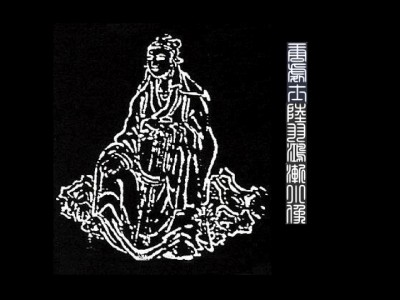
The Autobiography of Imperial Instructor Lu
The given name of Master Lu is Yü and his courtesy name is Hongjian. It is not known where he is from. Some say that his courtesy name is Yü and that his given name is Hongjian, not knowing which is right.1 He is as ugly as Zhongxüan and Mengyang and stutters like Xiangru and Ziyün,2 but he is talented and persuasive and sincere in character. In temperament, he is biased and irascible and often subjective. When his friends admonish him, however, he is at once liberal and respectful. Whenever he is at a gathering and happens to think of something, he leaves without speaking, causing people to wonder if he is scornful. But when he makes a promise to someone, he keeps his word, even though the path is a thousand li3 in length, filled with ice and snow, and infested with tigers and wolves.
At the beginning of the Shangyüan reign period,4 Lu Yü built a hut on the banks of Tiaoxi Stream.5 Closing his door, he now reads books for pleasure. He does not mix with riffraff, but spends long days talking and gathering with eminent monks and lofty scholars. It is his habit to roam about in his skiff to mountain temples, wearing only a gauze kerchief, plaited sandals, a short shirt and briefs, and loincloth. He often walks alone in the wilds chanting Buddhist scripture and reciting ancient poetry. Knocking about the trees with his staff and dabbling his hand in flowing water, he aimlessly wanders from dawn to dusk until the day is utterly dark, wailing and weeping, then finally returning home. Thus, people of Chu6 say among themselves, “Master Lu is now today’s Jieyü.7
Beginning at the age of two,8 desolate and exposed,9Lu Yü was raised at the Zen Buddhist Monastery10 of the great teacher Priest Jigong11 in Jingling. From the age of eight, he learned composition, and Jigong revealed to him through the scriptures the Buddhist calling of renouncing the world. In response, the boy said, “Without brothers, to have no descendants, to don monks’ robes and be tonsured, to call oneself a Buddhist – if the Confucians were to hear this, would they praise it as filial piety? May Yü be taught the writings of the sage Confucius?”12
Jigong replied, “Virtuous, indeed! You are filial, but you really do not yet know the Way of the tonsure and the robes of the West.13 Its name is truly great!” Jigong insisted on teaching the Buddhist scriptures without submitting to the will of the boy. The boy insisted on learning the Confucian canon without submitting to the will of the teacher. Then, Jigong feigned disaffection for the boy and assigned him a sequence of demeaning tasks to test him: sweep the temple grounds, clean the monks’ privy, mix mud with his feet and plaster the walls, carry tiles on his back and build rooms, and tend thirty head of cattle.
In Jingling and Xihu,14 there was no paper for the boy on which to write and learn calligraphy. So, using a bamboo stick, Lu Yü traced characters on the backs of the cattle. One day, he questioned a scholar about calligraphic characters and was given a scroll of the poem “Ode on the Southern Capital” by Zhang Heng.15 Not knowing the characters in the poem, he sat alone in the pasture, imitating the dark robed student boys, sitting up straight, the scroll unrolled, just silently moving his mouth.
When Jigong learned of this, he feared the boy was being imbued with heretical teachings, departing from the Way, ever distant with every day. So, the boy was again confined to the temple grounds and ordered to cut brambles and weeds under the direction of the senior disciple. Occasionally, written characters would come to mind and he would fall into a stupor as if lost and disheartened, standing like a wooden post, passing the day unmoving. The disciple thought he was lazy and whipped him. And so, the boy cried without restraint, lamenting, “Alas, the months and years are passing by and I fear I will never know writing and books!” The disciple thought the boy harbored resentment and again whipped his back, breaking the cane before releasing him.
Weary of these chores, the boy escaped from the senior disciple and ran away. With just a roll of clothes, he joined an itinerant troupe of actors for which he wrote the play Mocking Banter in three acts and played the leading roles of the blockhead, the phony civil servant, and the character who conceals the pearl. Priest Jigong pursued the boy and caught up with him, saying, “When I think of you lost to the Way! Alas, what a pity! Our founding master16 said that of the twelve hours of a disciple’s time, period was allowed for the study of non Buddhist teachings in order to subdue heretical thoughts. Because our monastery has so many people, you may now follow your desire. You can throw away all those song and dance books!”
During the Tianbao reign period,17 people of the ancient capital of Ying18 held a banquet at Canglang19 to which the district official invited Lu Yü to be master of ceremonies.20 At the time, Master Li Qiwu,21 of Honan, who was demoted and serving as governor of Jingling, perceived Lu Yü’s extraordinary talent. Taking Lu Yü’s hand and patting his back, Li then personally presented a collection of poetry to him. Thereafter, the Han and Mian region was transformed.22. Later, Lu Yü carried his books to Mount Huomen to study with Master Zou23 in the countryside. When Cui Guofu,[24] a director of the ministry of rites, assumed the office of prefect of Jingling, Lu Yü accompanied him here and there for all of three years. He gave Lu Yü a white donkey, a black humped ox,25 and a bookcase of pagoda wood with a beautiful grain. The white donkey and the humped ox were presents to Cui Guofu from Li Cheng,26 prefect of Xiangyang; the fine-grained case of pagoda wood27 was from the late vice-president Lu28 of the chancellery. Since Lu Yü had already admired these things, it was fitting that a rustic such as he ride and keep them. So, Cui Guofu especially gave them to him.
At the beginning of the Zhide reign period,29 the people of Qin30 crossed south over the Yangzi River, and Lu Yü also crossed31 and met the Buddhist monk Jiaoran32 of Wuxing:33 the commoner and the priest ignored their difference in age.34
Ever since he was young, Lu Yü had enjoyed writing, mostly satirical protests. Seeing people do good, he felt good. Seeing people doing evil, he felt shame. Bitter words grate on the ear. There was nothing and no one that he would not confront; things that an ordinary person would perforce shun. In response to the An Lushan35 rebellion, he wrote the poem “Four Lamentations.” In response to the revolt of Liu Zhan36 in the Jianghuai,37 he wrote the ode “The Obscuring of Heaven.” Both these events moved him to cry and weep. Other writings include The Bonds between Ruler and Subject in three volumes, Unraveling Origins in thirty volumes, Genealogy of Four Surnames South of the Yangzi River in eight volumes, A Record of Famous People from North and South in ten volumes, A Record of Successive Officials in Wuxing in three volumes, A Critical History of Huzhou Prefecture in one volume, The Book of Tea in three volumes, The Interpretation of Dreams, first, second, and third parts, in three volumes, all of which is kept in a coarse cloth sack.
Written in the autumn of 761, the xinchou year of the Shangyüan reign period at the age of twenty-eight.38
陸文學自傳
陸子名羽,字鴻漸,不知何許人也。或雲字羽名鴻漸,未知孰是?有仲宣孟陽之貌陋,相如子雲之口吃,而為人才辯篤信,褊躁多自用意,朋友規諫,豁然不惑。凡與人宴處,意有所適,不言而去,人或疑之,謂生多瞋。及與人為信,雖水雪千裏,虎狼當道,而不愆也。上元初,結廬於苕溪之濱,閉關對書,不雜非類,名僧高士,談宴永日。常扁舟往來山寺,隨身惟紗巾藤鞋短褐犢鼻,往往獨行野中。誦佛經,吟古詩,杖擊林木,手弄流水,夷猶徘徊,自曙達暮,至日黑興盡,號泣而歸。故楚人相謂,陸子蓋今之接輿也。始三歲惸露,育乎竟陵大師積公之禪院。自幼學屬文,積公示以佛書出世之業。子答曰:「終鮮兄弟,無複後嗣,染衣削發,號為釋氏,使儒者聞之,得稱為孝乎,羽將授孔聖之文可乎?」公曰:「善哉子為孝,殊不知西方染削之道,其名大矣。」公執釋典不屈,子執儒典不屈,公因矯憐無愛,曆試賤務。掃寺地,潔僧廁,踐泥汙牆,負瓦施屋,牧牛一百二十蹄。竟陵西湖無紙,學書以竹畫牛背為字,他日問字於學者,得張衡《南都賦》,不識其字,但於牧所仿青衿小兒,危坐展卷,口動而已。公知之,恐漸漬外典,去道日曠,又束於寺中,令其翦榛莽,以門人之伯主焉。或時心記文字,懵然若有所遺,灰心木立,過日不作,主者以為慵惰鞭之。因歎歲月往矣,恐不知其書,嗚咽不自勝。主者以為蓄怒,又鞭其背,折其楚乃釋。因倦所役,舍主者而去,卷衣詣伶黨,著《謔談》三篇。以身為伶正,弄木人假吏藏珠之戲。公追之曰:「念爾道喪,惜哉!吾本師有言,我弟子十二時中,許一時外學,令降伏外道也。以我門人眾多,今從爾所欲,可緝學工書。」天寶中,郢人酺於滄浪道,邑吏召子為伶正之師。時河南尹李公齊物出守見異,捉手拊背,親授詩集,於是漢沔之俗亦異焉。後負書於火門山鄒夫子別墅,屬禮部郎中崔公國輔出守竟陵郡,與之遊處凡三年,贈白驢烏、幫牛一頭,文槐書函一枚。白驢、幫牛襄陽太守李憕見遺,文槐函故盧黃門侍郎所與,此物皆已之所惜也。宜野人乘蓄,故特以相贈。洎至德初,秦人過江,子亦過江,與吳興釋皎然為緇素忘年之交。少好屬文,多所諷諭。見人為善,若已有之;見人不善,若已羞之。苦言逆耳,無所回避,由是俗人多忌之。自祿山亂中原,為《四悲詩》,劉展窺江淮,作《天之未明賦》,皆見感激當時,行哭涕泗。著 《君臣契》三卷,《源解》三十卷,《江表四姓譜》八卷,《南北人物誌》,十卷,《吳興曆官記》三卷,《湖州刺史記》一卷,《茶經》三卷,《占》夢上中下三卷,並貯於褐布囊。上元辛醜歲,子陽秋二十有九。
Source
Lu Wenxüe zijuan 陸文學自傳 (The Autobiography of Imperial Instructor Lu, 761), Wenyüan yinghua 文苑英華 (Beautiful Blossoms from the Literary Garden, ca. 1009), Li Fang 李昉 (925-996) et al., comps., ch. 793.
Figure
Small Portrait of the Tang Eremite Lu Hongjian, Tang chushi Lu Hongjian xiaoxiang 唐處士陸鴻漸小像, ink rubbing of an engraved image on a stone stele originally installed in the Lugong ci 陸公祠 or Shrine of Master Lu. The shrine was once built in 1783 on the moat outside the north gate of the Jingling city walls. In 1988, the shrine was rebuilt on the site of the former West Pagoda Temple, Xita si 西塔寺.
Notes
1 This sentence is sometimes rendered as parenthetical and considered a later interpolation by scholars such as Zhang Hongyong 張宏庸, Lu Yü qüanji 陸羽全集 (Taibei: Chaxüe wenxüe chuban she, 1985), p. 88, n. 2.
2 Lu Yü compared his verbal and physical afflictions to those of four famous poets of the Han and Wei dynasties: Wang Can 王粲 (177-217), Zhang Zai 張載 (ca. 289), Sima Xiangru 司馬相如 (c. 179-117 B.C.E.), and Yang Xiung 揚雄 (53 B.C.E.-C.E. 18), respectively.
3 Li 里, a little over a third of a mile.
4 The Shangyüan 上元 reign period (760-761 C.E.) lasted a nominal two years; therefore, the year that Lu Yü established his residence was 760.
5 The Tiaoxi 苕溪 or Reed Stream is a major geographical and seasonal feature of Huzhou 湖州, the town in northern Zhejiang where Lu Yü eventually settled, lived, and died. The name Reed Stream comes from the marsh plant that grows abundantly along the river bank; it blossoms in white, feathery plumes in summer and in autumn goes to seed, showering the air and water with a snowy fluff. Broad and shallow, the river flows in two main branches, east and west, out of Mount Tianmu 天目山, converges in the town of Huzhou, and then empties north into Lake Tai 太湖.
6 Chu 楚 was a name for the ancient state and region of Hupei and Hunan where Lu Yü was born.
7 Jieyü 接輿 was an eccentric of the Spring and Autumn Period (772-481 B.C.E.) known as the Mad Man of Chu.
8 The text reads, “Beginning at sansui 三歲 (three years of age),” however, by Chinese custom, age begins at conception and a person is one year old at birth; therefore, Lu Yü was abandoned at the age of two, by Western count.
9 Lu Yü was a foundling discovered on the banks of a stream.
10 The Zen Buddhist Monastery was formally known as the Jingling Longgai si 竟陵龍盖寺, the Temple of the Hidden Dragon at Jingling. The monastery was originally built on Fufu Island 覆釜洲 in the middle of West Lake 西湖. Established as early as the late Han, the temple expanded greatly in the fourth century during the Eastern Jin. In the eighth century, the renown of the temple drew famous clerics and important convocations. Lu Yü was raised at the temple as a servant and novice. Presently known as the Xita si 西塔寺 or West Pagoda Temple, the monastery was rebuilt in 2003 just north of West Lake.
11 Abbot Zhiji 智積 (a.k.a. Jigong 積公; active 735-768).
12 At one time, a Buddhist novitiate severed relations with his family, took a vow of celibacy, and was divorced from mundane, secular concerns. In Confucian terms, becoming a monk was considered unfilial to his parents, an unnatural cessation of the family line, an unproductive member of society, and disloyal to the state.
13 The West refers to India, the birthplace of Buddhism, and also to the Indian monk Bodhidharma (ca. 460-532/534), the patriarch of Zen Buddhism, who traveled west from India to China in circa 520 to spread his teachings.
14 Jingling 竟陵 was the ancient name of present Tianmen 天門, a town just sixty-seven miles west of the city of Wuhan 武漢, Hubei province 湖北省. Jingling 竟陵 literally means “end of hills,” that is to say, a flat plain with no hills at all. The town is famously known as Lu Yü guli 陸羽故里or the birthplace of Lu Yü. Xihu 西湖 or West Lake is a great pond just outside the western gate of old Jingling and was so called because it mirrored East Lake, Donghu 東湖 across town. West Lake is presently a large water park with buildings commemorating the life and work of Lu Yü.
15 Zhang Heng 張衡 (78-139), a distinguished poet, astronomer, and mathematician of the Eastern Han period (25-220), whose Nandu fu 南都賦 (Ode on the Southern Capital) depicted the region, products, scenic and historic places, and social customs of the provincial capital of Nanyang, present day Honan.
16 Priest Jigong did not identify the founder of the Longgai Temple 龍蓋寺, but its most famous abbots were the Buddhist philosopher Zhidun 支遁 (314-366) and the Buddhist scholar Yanzong 彦琮 (557-610) both of whom presided over the monastery when it was one of the most important monastic establishments in China. Circa 353, Zhidun was recorded as having enclosed a freshwater spring on the temple grounds, a place that later became known as Spring of the Imperial Instructor, Wenxüe qüan 文學泉, because of its association with Lu Yü (Zhou Shiping 周世平 and Tong Zhengxiang 童正祥, “Lu Yü guzhu ‘Xita si yüanliu’ kao 陸羽故居 ‘西塔寺源流’ 考 (A Study of the Residency of Lu Yü and the ‘Origins of West Pagoda Temple’), Chayüan 茶苑 (Tea Garden Journal, 2003), no. 2, pp. 31-33).
17 Tianbao reign period, 742-755.
18 Ying 郢 was the capital of the ancient state of Chu 楚, now known as Jiangling 江陵 or Jingzhou 荆州, Hupei.
19 Canglang 滄浪 is a branch of the Han River 漢水 at its lower reaches near Jingzhou 荆州, Hupei.
20 Lu Yü was but thirteen years of age when he received the invitation to direct the entertainments for the festivities.
21 Li Qiwu 李齊物 (active ca. 742-755), a former governor of Loyang, a distinguished scholar, courtier, and respected high official in the Tang government who in his later years was Grand Mentor of the Heir Apparent, one of three preceptors to the crown prince. Li spent a number of years in exile as prefect of Jingling.
22 Han 漢 and Mian 沔 rivers, i.e., the people of the region. The Mian is a branch of the Han River.
23 Zou Kun 鄒坤 (active ca. 747), headmaster of the Confucian academy on Mount Huomen 火門山, northwest of Jingling 竟陵, Hupei. See Kou Dan 寇丹, Lu Yü yü Chajing yanjiu 陸羽與茶經研究 (Hong Kong: Tianma tushu, Ltd., 2002), p. 102, no. 18.
24 Cui Guofu 崔國輔 (js 726), a Tang poet, courtier, and official, who in 752 was appointed prefect of Jingling.
25 A zebu (Bos indicus), an Asian domestic ox with a large hump over its shoulders, short curved horns, a large dewlap, and pendulous ears.
26 Li Cheng 李憕 ( ? – 755), a high official promoted to the post of minister in the Ministry of Rites after the An Lushan rebellion of 755.
27 Pagoda wood (Sophora japonicus), also known as the scholar’s tree and traditionally cultivated as a garden plant by aspiring students.
28 The official Lu 盧 of the chancellery, unidentified.
29 Zhide reign period, 756-757.
30 Qinren 秦人: Refugees from the province of Shaanxi fleeing the conflict and rebellion in the north to the relative safety of the south below the Yangtze River.
31 In 756, Lu Yü traveled northeast to Wuxing 吳興, Zhejiang, a place south of the Yangzi River and therefore still considered “south.”
32 Jiaoran 皎然 (720-799), a Buddhist priest, literary critic, and noted poet whose radical “use of poetry as an intellectual instrument,” “juxtaposition of Zen Buddhism and the arts,” and theory made him the dominant literary figure of the lower Yangzi (William H. Nienhauser, Jr., ed. and comp., The Indiana Companion to Traditional Chinese Literature (Bloomington: Indian University Press, 1986), pp. 270-273).
33 Jiaoran was from the town of Huzhou 湖州 in Wuxing 吳興, Zhejiang, where Lu Yü eventually settled and spent the rest of his life.
34 Lu Yü (733-804) and Jiaoran (720-799) differed in age by about thirteen years. The year 720 is given as the date of Jiaoran’s birth; 799 as his date of death (Xü Hairong 徐海榮, ed., Zhongguo chashi dadian 中國茶事大典 (Beijing: Huaxia chuban she, 2000), p. 561 and William H. Nienhauser, Jr., ed. and comp., The Indiana Companion to Traditional Chinese Literature (Bloomington: Indian University Press, 1986), p. 270, respectively).
35 An Lushan 安祿山 (703-757) rebelled on the ninth day of the eleventh month of 755. Within months, refugees were fleeing the conflict from Shaanxi to the relative safety of the south.
36 Liu Zhan 劉展 ( ? – 761), a rebel in the lower Yangzi River valley, especially around Suzhou and the wealthy trading towns of Yangzhou and Chuzhou. Liu rebelled during the winter of 760-761 and was killed by government troops.
37 Jianghuai 江淮: Jiangsu, Honan, and northern Anhui provinces.
38 Lu Yü was twenty-nine sui 歲, Chinese years, making him age twenty-eight by Western reckoning.
Tianluoshan: Reprise
Tea in the Neolithic Era or Getting to the Root of the Matter
There is an ongoing discussion within the archaeological community regarding the discovery of Camellia plant remains at the late Stone Age site of Tianluoshan, particularly the notion that the tea plant Camellia sinensis was domesticated.
The discourse concerns the sufficiency and analysis of data. Unlike the announcements of the discovery of Neolithic tea, exchanges over issues regarding the find take place in less public forums. However, all agree that the archaeology is sound and the discovery of Camellia roots is not in dispute. Moreover, there is an accord that the Camellia rhizomes, like the other botanicals found at Tianluoshan, are an important discovery.
Several concerns remain among archaeologists. While accepting the excavation of Camellia roots from within the residential area of the settlement, some have reservations as to whether the rhizomes were planted, suggesting instead that the spacing of the plants as well as the surrounding light-colored earth were naturally formed along the expanding growth of the roots. And though Tianluoshan is five meters above sea level, some question the growth of Camellia near marshy ground. Without proof of planting, the Camellia may not have been under cultivation, and so the specific ethnobotanical connections between these plants and the settlement community remain archaeologically yet unclear.
Although there is agreement that the roots are genus Camellia, there is no consensus as to species. This particular issue hinges on the chemical analysis used to determine plant species. Some further cite the lack of wild Camellia sinensis with which to compare the excavated Camellia rhizomes. Issues aside, the general concession is that the Camellia plant remains at Tianluoshan are most likely Camellia sinensis, while others encourage further investigation and the gathering of more information.
As for the Camellia roots at Tianluoshan, it remains to be seen as to whether or not the archaeological community will clarify the situation and come to unanimity. One step towards solution, once proposed by the archaeobotanists, is testing the DNA of the specimens. In the meantime, there continues to exist a respectful debate.
Acknowledgements
Many thanks to Dr. Ling-yu Hung for her inquiry into the controversy over Neolithic tea. And thanks to Dr. Qin Ling, archaeobotanist at the School of Archaeology and Museology, Beijing University and Dr. John T. Kirby, Professor and Chair of the Department of Classics, University of Miami for their kind assistance.
Tianluoshan: Tea in the Neolithic Era
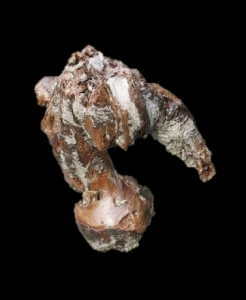 In 2001, the remains of a Neolithic settlement were discovered near the eastern coast of China where archaeologists excavated nearly a dozen roots of the tea plant Camellia sinensis. Each rhizome was found in an extraordinary state of preservation and in a regular pattern of planting. The remarkable find dramatically changed the history of tea by extending the geographical range of primordial Camellia sinensis from the remote fastness of Sichuan in the far west eastward to the marshes and streams of the lower Yangzi and the Zhejiang coast. Moreover, tea culture was no longer confined to the historical period but stretched thousands of years back in time to the fourth millennium B.C. of the late Stone Age. Continue Reading →
In 2001, the remains of a Neolithic settlement were discovered near the eastern coast of China where archaeologists excavated nearly a dozen roots of the tea plant Camellia sinensis. Each rhizome was found in an extraordinary state of preservation and in a regular pattern of planting. The remarkable find dramatically changed the history of tea by extending the geographical range of primordial Camellia sinensis from the remote fastness of Sichuan in the far west eastward to the marshes and streams of the lower Yangzi and the Zhejiang coast. Moreover, tea culture was no longer confined to the historical period but stretched thousands of years back in time to the fourth millennium B.C. of the late Stone Age. Continue Reading →
Spring of the Instructor: Wenxüe qüan 文學泉
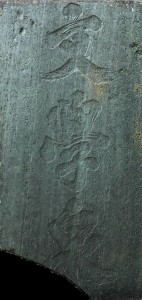 The Spring of the Instructor was once an important source of water in the ancient town of Jingling. Pure and clear, the spring was discovered long ago by a venerated monk, and for hundreds of years thereafter its waters were used to brew tea at the nearby monastery. As the basic medium for making tea, the spring’s sweet water was essential and preferred for its purity, clarity, and taste. According to tradition, the Tang tea master Lu Yü drew water from the spring as a boy. Many sources of fine water were credited to Lu Yü during his lifetime, but the spring at Jingling was plainly identified with his adolescence, giving it precedence above all others in the shaping of his taste and ideas on tea. Lu Yü later used the knowledge he gathered from his early time at the spring to write the Chajing 茶經, the Book of Tea. From the late Tang dynasty through the twentieth century until today, the site of the spring was ornamented with pavilions and halls to commemorate the Book and life of Lu Yü, the Sage of Tea. Continue Reading →
The Spring of the Instructor was once an important source of water in the ancient town of Jingling. Pure and clear, the spring was discovered long ago by a venerated monk, and for hundreds of years thereafter its waters were used to brew tea at the nearby monastery. As the basic medium for making tea, the spring’s sweet water was essential and preferred for its purity, clarity, and taste. According to tradition, the Tang tea master Lu Yü drew water from the spring as a boy. Many sources of fine water were credited to Lu Yü during his lifetime, but the spring at Jingling was plainly identified with his adolescence, giving it precedence above all others in the shaping of his taste and ideas on tea. Lu Yü later used the knowledge he gathered from his early time at the spring to write the Chajing 茶經, the Book of Tea. From the late Tang dynasty through the twentieth century until today, the site of the spring was ornamented with pavilions and halls to commemorate the Book and life of Lu Yü, the Sage of Tea. Continue Reading →
Tsia and Tsiology: A History of the Words
Introduction
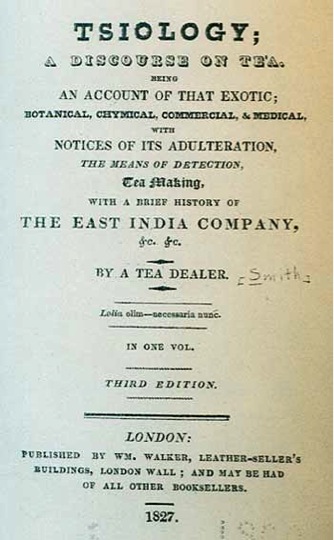 The word tsiology is a nineteenth century expression. Rare and obscure, tsiology was said to mean “a scientific dissertation on tea.”[1] As a term, tsiology was expressly coined in 1826 for a polemical account published that very year in London. In keeping with the expository style of titles of the time, the name of the book ran on at some length: Tsiology: A Discourse on Tea. Being an account of that exotic, botanical, chymical, commercial and medical, with notices of its adulteration, the means of its detection, Tea making, with a brief history of The East India Company, etc. The small, one volume book was written by an English author who anonymously and simply referred to himself as “A Tea Dealer.”[2] In addition to being an exposition on tea, Tsiology was a defense of the East India Company monopoly and a critique of not only escalating government tariffs but also of fraudulent schemes disrupting the domestic tea trade. Tsiology temporarily attracted London readers with its facade of scholarship, the book surviving three editions printed over a year or so.[3] While the book raised several important and timely issues about the British trade, the term tsiology never gained acceptance as an expression of tea, and indeed it all but vanished from literary as well as spoken English. Continue Reading →
The word tsiology is a nineteenth century expression. Rare and obscure, tsiology was said to mean “a scientific dissertation on tea.”[1] As a term, tsiology was expressly coined in 1826 for a polemical account published that very year in London. In keeping with the expository style of titles of the time, the name of the book ran on at some length: Tsiology: A Discourse on Tea. Being an account of that exotic, botanical, chymical, commercial and medical, with notices of its adulteration, the means of its detection, Tea making, with a brief history of The East India Company, etc. The small, one volume book was written by an English author who anonymously and simply referred to himself as “A Tea Dealer.”[2] In addition to being an exposition on tea, Tsiology was a defense of the East India Company monopoly and a critique of not only escalating government tariffs but also of fraudulent schemes disrupting the domestic tea trade. Tsiology temporarily attracted London readers with its facade of scholarship, the book surviving three editions printed over a year or so.[3] While the book raised several important and timely issues about the British trade, the term tsiology never gained acceptance as an expression of tea, and indeed it all but vanished from literary as well as spoken English. Continue Reading →
Wandering Immortal
Guo Pu of the Eastern Jin
Wandering Immortal
The bustling capital is a pitfall for wayward gentlemen.
The mountain forest is seclusion for hermits.
No need to exalt the vermillion gate;
It is incomparable to embracing Penglai,
Where right from the Source I ladle pure water,
Where from the hills and mountains I gather cinnabar mushrooms.
Spirit Stream conceals me well:
No need to climb the Ladder of Clouds.
Lacquer Garden had Chuangzi;
Master Lai, a reclusive wife.
Advancing ensures seeing the dragon but
Retiring is like a ram butting a fence.
On the high Path, I abandon the swirling dust,
Bidding farewell to Boyi and Shuqi.
Bring in the Wine
Li Bai of the Tang dynasty
Bring in the Wine
Have you not seen the Yellow River waters flowing from Heaven,
Rushing to the sea, never to return?
Have you not seen parents’ sorrow in their white hair?
Once, it was like black silk at dawn, now at sunset it’s like snow.
A life fulfilled must contain happiness:
Never let the golden vessel go empty, just add the moon!
Born with Heaven’s gifts, I must use them;
I’ve scattered thousands in gold and it all returns to me.
Boil the mutton, butcher the ox, all for joy!
Muster a draught of three hundred cups!
Elder Cen and Master Danqiu,
Bring in the wine, the ceaseless cups.
Just one more song for you,
Please just listen closely.
Bells and drums, delicacies and jade? All nothing!
I just want one long binge, not sobriety!
Old sages and worthies? All forgotten!
Only great drunks leave behind their names.
Prince Chen once feasted in the Temple of Tranquil Joy,
Worth tens of thousands, casks of wine indulged every pleasure.
So how dare I say my money is running out?
Go buy more wine and fill our cups.
My fine dappled horse, my precious furs,
Call over the servant boy, exchange them for rare wines.
Together we’ll wash away ten thousand old sorrows.

